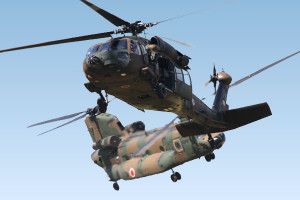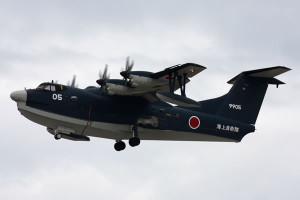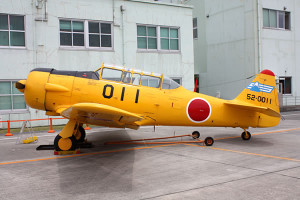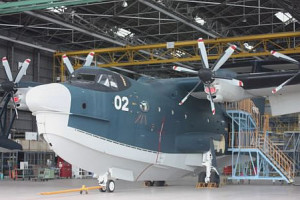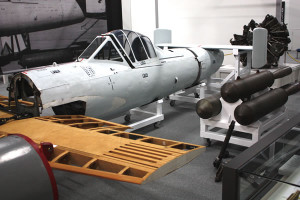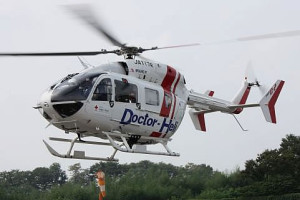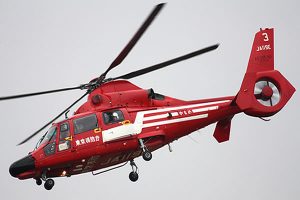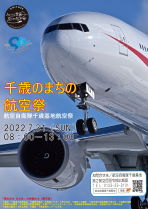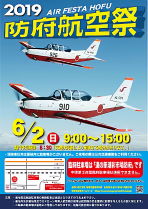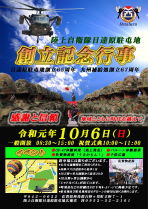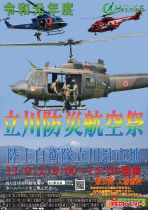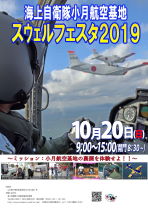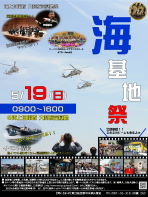JGSDF Squadron Histories & Markings Part 1

(Above) As a Blue Impulse aerobatic team pilot looks on, a Kawasaki-Bell H-13KH bearing the
IV of the 4th AvSqn departs JASDF Tsuiki AB in November 1974. (Photo: Takao Kadokami)
(Below) As a crew member follows standard procedure by acting as window lookout, the pilot of a 1st Helicopter Brigade CH-47JA kicks up the grass during the landing phase at Kisarazu in the late 1990s. The aircraft bears the native American/American Indian warrior’s head marking of the 2nd Helicopter Group and double yellow stripes, denoting the 2nd Flight, beneath the nose and on the sponson.
The Kazusa Flight was re-designated as the 106th Sqn in 2003. (Photo: JGSDF)

Although perhaps not quite enjoying the same high profile as, say, JASDF fighter squadrons, JGSDF aviation units have quietly accumulated operational experience that can date back many years.
The main listing is broken down first into numerical order by standard unit number. This is followed by the five anti-tank helicopter units, the elements under regional army command and then other elements, including aviation schools.
| Part 1 | |
| 1st Combat Helicopter Squadron | |
| 1st Helicopter Corps (1959-68) | 1st Transport Helicopter Group (2008-) |
| 1st Helicopter Brigade (1968-2008) | 1st to 11th Aviation Squadrons |
| Part 2 (on separate page) | |
| 12th Helicopter Unit | 15th Helicopter Unit (2013-) |
| 13th to 14th Aviation Squadrons | 101st Aviation Squadron (1972-2010) |
| 15th Aviation Squadron (2010-13) | 102nd to 109th Squadrons |
| 1st to 5th Anti-Tank Helicopter Units (3rd ATH redesignated 1st Combat Helicopter Sqn Mar. 2021) |
|
| Regional Army Aviation Groups | Regional Army Helicopter Squadrons |
| (North / Northeastern / Eastern / Central / Western) | |
| Special Transport Helicopter Squadron | |
| Main Aviation School/Branch Schools Training Support Organisation |
|
| Experimental Flying Unit | |
Some text entries are still pending, others sketchy. In addition to photographic content, J-HangarSpace is gradually adding more operational facts and figures, particularly those gleaned from the unit visits made over the years by the Japanese aviation press. Naturally, no account would be complete without some input from unit personnel.
The information covers unit markings, and even the JGSDF is known to decorate its usually sombrely camouflaged aircraft with special colour schemes when the occasion merits.
 A typical scene on a summer’s day at the Utsunomiya branch of the Army Aviation School, with
A typical scene on a summer’s day at the Utsunomiya branch of the Army Aviation School, with
TH-480B training in full swing (Photo: JGSDF)
| Glossary of Principal Terms | ||||
| Air Training Support Squadron (1976–2019) |
Kyōikushien Hikōtai | 教育支援飛行隊 | ||
| Anti-Tank Helicopter Unit | Taisensha Herikoputa-tai | 対戦車ヘリコプター隊 | ||
| Aviation Corps | Kōkūtai | 航空隊 | ||
| Aviation School Unit (2019–) |
Hikōkyōdōtai | 飛行教導隊 | ||
| (Aviation) Squadron (AvSqn) | Hikōtai | 飛行隊 | ||
| Combat Helicopter Squadron* | Sentō Herikoputa-tai | 戦闘ヘリコプター隊 | ||
| Composite Brigade | Konseidan | 混成団 | ||
| District Aviation Corps** | Kanku Kōkūtai | 管区航空隊 | ||
| Fuji Flight Group (1962–) |
Fuji Hikōhan | 富士飛行班 | ||
| Fuji School Aviation Group (1955–62) |
Fuji Gakkō Kōkūhan | 富士学校航空班 | ||
| HQ Control Flight | Honbukanri Chūtai | 本部管理中隊 | ||
| Helicopter Brigade | Herikoputa-dan | ヘリコプター団 | ||
| Helicopter Corps (1959-68) | Herikoputa-tai | ヘリコプター隊 | ||
| Helicopter Group (1968) | ||||
| Helicopter Flight (KV-107/CH-47) | Herikoputa-hikōtai | ヘリコプター飛行隊 | ||
| Helicopter Squadron | ||||
| Helicopter Unit | Herikoputa-tai | ヘリコプター隊 | ||
| National Security Force (NSF) | Hōantai | 保安隊 | ||
| [Region] Army Aviation Group | Hōmen Kōkūtai | 方面航空隊 | ||
| [Region] Army Aviation Squadron | Hōmen Hikōtai | 方面飛行隊 | ||
| [Region] Army Helicopter Squadron | Hōmen Herikoputa-tai | 方面ヘリコプター隊 | ||
| [Region] Army HQ Flight | Hōmen Kōkūtai Honbutsukitai | 方面航空隊本部付隊 | ||
| Transport Aviation Group*** | Yusōkōkūtai | 輸送航空隊 | ||
| Transport Helicopter Group | Yusō Herikoputa-gun | 輸送ヘリコプター群 | ||
| (*) Designation of former 3rd Anti-Tank Helicopter Unit (q.v.) from March 2021 (**) Used in NSF era from Jan. 10, 1954, and up until reorganization of JGSDF on Jan. 18, 1962 (***) Newly formed on March 26, 2020, prior to delivery of first Ospreys |
||||
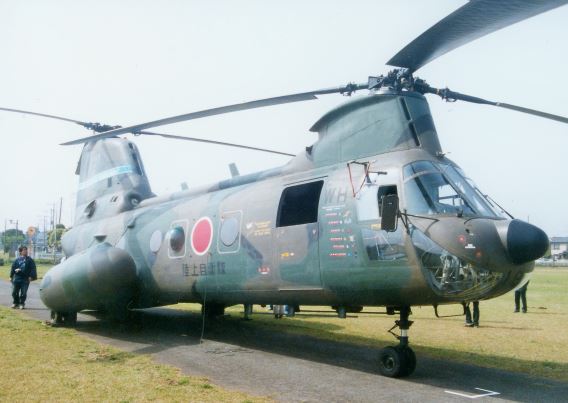 Former Western Army Helicopter Squadron KV-107IIA-4 51818 at Kasumigaura on a hazy morning in
Former Western Army Helicopter Squadron KV-107IIA-4 51818 at Kasumigaura on a hazy morning in
May 2002. The last retiree of a total of 60 KV107IIs delivered from 1966 to 1981, the aircraft is now
displayed at the Crossland Oyabe amusement park in Toyama Prefecture.
 At that time in 2002, KV-107IIA-4 51818 was decorated with the names (radio call signs) and insignia
At that time in 2002, KV-107IIA-4 51818 was decorated with the names (radio call signs) and insignia
of the units with which the aircraft had served since 1966. The number of stripes indicated the
flight within those units. From top to bottom these were:
Katori (1st Helicopter Brigade, 1st Helicopter Group, 1st Flight)
Azuma (1st Helicopter Brigade, 1st Helicopter Group, 2nd Flight)
Akagi (1st Helicopter Brigade, 2nd Helicopter Group, 1st Flight)
Kazusa (1st Helicopter Brigade, 2nd Helicopter Group, 2nd Flight)
Seasir (101st AvSqn, Okinawa) and
Kawasemi (Japanese for kingfisher, Western Army Helicopter Squadron, 3rd Flight)
|
1st Combat Helicopter Sqn |
Formed | Mar. 10, 2021 (Metabaru) |
| Current Base | Metabarau |
This unit was formed the day after its predecessor, the 3rd Anti-Tank Helicopter Sqn, had flown its AH-1Ss for the last time and disbanded one of its two flights. An HQ Flight operates the OH-1.
 (Photo [posted Jan. 2022]: Tommy via Twitter @b777300erhnd)
(Photo [posted Jan. 2022]: Tommy via Twitter @b777300erhnd)
 Two aircraft from this unit participated in the Rising Thunder 2021 joint exercise that was held at
Two aircraft from this unit participated in the Rising Thunder 2021 joint exercise that was held at
the U.S. Army’s Yakima Training Center in Washington state. The first Japanese troop elements
having arrived in the U.S. on November 1 that year, the exercise—the first at which a
JGSDF helicopter fired a Hellfire missile—was wound up on December 14.
 (Photos [via DVIDS, taken Dec. 3, 2022]: U.S. Army/Capt. Kyle Abraham,
(Photos [via DVIDS, taken Dec. 3, 2022]: U.S. Army/Capt. Kyle Abraham,
16th Combat Aviation Brigade)
Unit Markings
 Aircraft assigned to this unit carry the identifier IBH, presumably meaning Battle Helicopter,
Aircraft assigned to this unit carry the identifier IBH, presumably meaning Battle Helicopter,
aft of the cockpit. (Photo [posted Jan. 2022]: Tommy via Twitter @b777300erhnd)
 Photo [JASDF Ashiya AB, Oct. 2023]: あおグースvia X [formerly Twitter] @AoGoose)
Photo [JASDF Ashiya AB, Oct. 2023]: あおグースvia X [formerly Twitter] @AoGoose)
|
1st Helicopter Corps |
Formed | Mar. 20, 1959 (Akeno) |
| Disbanded | Mar. 1, 1968 (Kasumigaura) |
Formed within the Akeno Aviation School on March 20, 1959, the 1st Helicopter Corps moved its Sikorsky H-19s and Vertol V-44As to Kasumigaura at the end of that month and was reorganized into 1st Helicopter Brigade on March 1, 1968 (see below).
 Representative of the aircraft operated by the 1st Helicopter Corps, one of the JGSDF’s two Vertol
Representative of the aircraft operated by the 1st Helicopter Corps, one of the JGSDF’s two Vertol
V-44As was on display at Okadama in August 1973. Displayed aircraft are often given markings
of current units, in this case the H of the then active 1st Helicopter Brigade. Having been
delivered in April 1959, the aircraft was withdrawn from service at Kasumigaura in
September 1971 and ended up at JGSDF Obihiro in Hokkaido in 2016.
(Photo: Akira Watanabe)
|
1st Helicopter Brigade |
Formed | Mar. 1, 1968 (Kasumigaura) |
| Disbanded | Mar. 27, 2008 (Kisarazu) (See 1st Transport Helicopter Group below) |
Formed from the 1st Helicopter Corps at Kasumigaura on March 1, 1968, the original 1st Helicopter Brigade comprised two helicopter groups (herikoputatai), each made of two helicopter flights (herikoputahikōtai). There followed a phased relocation to Kisarazu, with the 1st Helicopter Brigade HQ and the 1st Helicopter Group moving on March 22 of that year. Accompanied by the 1st Field Maintenance Unit, the 2nd Helicopter Group’s 1st Helicopter Squadron followed on June 1, 1968, its 2nd Helicopter Squadron in August 1969.
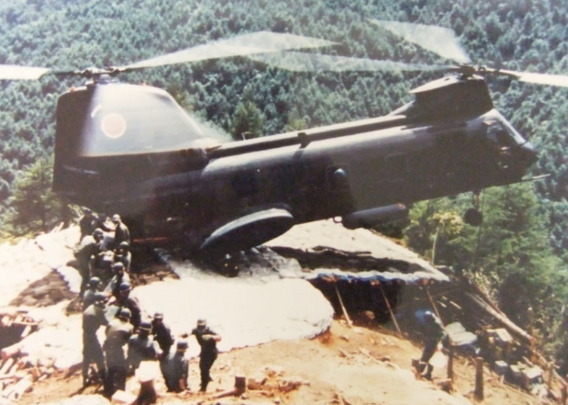 A 1st Helicopter Brigade KV-107 pilot displays his airmanship skills during operations
A 1st Helicopter Brigade KV-107 pilot displays his airmanship skills during operations
following the tragic Japan Airlines crash in Gunma Prefecture, August 1985.
(Photo: JGSDF Kisarazu)
Declared at full strength on the KV-107 helicopter in March 1975, re-equipment with the CH-47J took place between March 1988 and March 1995; the first CH-47JA arrived in December 1998. The 1st Helicopter Brigade received its first OH-6Ds in March 1977.
Placed under the command of the 1st Helicopter Brigade, the Special Transport Helicopter Squadron (see later) received its first AS332L in December 1986.
Equipped with the Fuji LM-1, a 1st Helicopter Brigade HQ command flight (Honbu Kanri Chūtai) was formed in 1974 and re-equipped with the LR-1 in March 1977 and the LR-2 in January 2000. A Liaison & Reconnaissance Flight was formed on March 27, 2006.
Formerly reporting direct to Ground Staff Office, the 1st Helicopter Brigade was integrated into the command structure of the newly formed Central Readiness Force on March 28, 2007. Its first response was to combat forest fires in Yamanashi Prefecture on April 29, 2007.
Further reorganization took place the following year, on March 27, 2008, when the 1st Helicopter Brigade was disbanded to make way for the 1st Transport Helicopter Group (see below), at which time the brigade’s two constituent (1st and 2nd) helicopter squadrons were reformed into four (103rd to 106th) eight-helicopter squadrons, confusingly now under the command of the 1st Helicopter Brigade.
Over the 40 years of its existence prior to this reorganization, the 1st Helicopter Brigade played a key role in a number of disaster relief missions.
 Delivered in 1987 as the last of five aircraft supplied by Boeing in kit form, CH-47J 52905 rests in
Delivered in 1987 as the last of five aircraft supplied by Boeing in kit form, CH-47J 52905 rests in
the sun at Tachikawa in November 1989. This was a time when the main JGSDF CH-47J fleet,
still in its infancy, was devoid of unit markings except for the IH denoting the
1st Helicopter Group. (Photo: Akira Watanabe)
1st Helicopter Brigade Markings
| Tail rotor mast (KV-107) Hinomaru national marking, later blank (CH-47) Blank, individual squadron marking from 90s |
||
| 1st Helicopter Group (IH) | 2nd Helicopter Group (IIH) | |
| 1st Flt | (KV-107) White fuselage stripe* (CH-47) White nose and sponson stripes |
(KV-107) As IH (CH-47) Yellow nose and sponson stripes |
| 2nd Flt | (KV-107) Two white fuselage stripes (CH-47) Two stripes on nose and sponsons |
(KV-107) As IH (CH-47) Two yellow stripes on nose and sponsons |
| HQ Flt | (OH-6) IHB only, no specific unit markings | |
| * Removed when camouflage scheme adopted | ||
1st Helicopter Group, 1st Flight/KV-107 era
Aside from the IH Roman numeral/letter combination applied aft of the cockpit windows, the sole identifying marking was a white stripe around the rear fuselage.
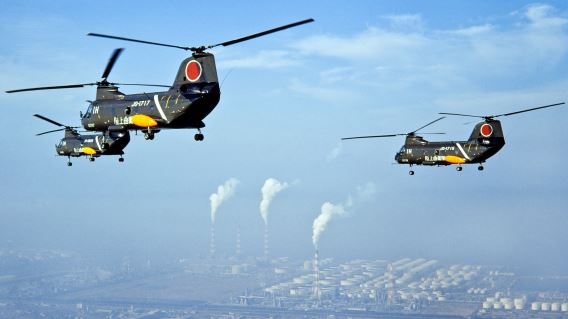 A formation of three KV-107II-4s from the 1st Helicopter Group, 1st Flight—as identified by the
A formation of three KV-107II-4s from the 1st Helicopter Group, 1st Flight—as identified by the
IH and single fuselage stripe—of the 1st Helicopter Brigade airborne over Chiba Prefecture’s
industrial heartland from Kisarazu on Christmas Eve 1977. (Photo: Akira Watanabe)
1st Helicopter Group, 1st Flight/CH-47 era
Around the autumn of 1993, the 1st Helicopter Group, 1st Flight aircraft started to sport an all-black design incorporating the words Heliborne Fleet above 1H1F, a pair of laurel leaves and 1st Helicopter Brigade on their tail rotor masts. From circa October 1998, the Heliborne Fleet and 1st Helicopter Brigade appeared in white, the 1H1F in red and the laurel leaves in yellow. To ease unit identification, a short white stripe was applied to both the nose and at a rakish angle on the front of the fuselage-side sponsons.
In around September 1999, the design was changed to a simple, white-shadowed red “1” wrapped by a lightning flash. The latter motif is associated with the Katori Shrine in northern Chiba Prefecture, where the god of thunder is believed enshrined. The design was flanked by the words Katori and Flight, in white, and above the base name, Kisarazu, also in white.
The top three blog photos here (link) chart the changes in the 1st Flight’s markings:
(1) Former marking, black version (photographed at Kisarazu September 1993)
(2) Former marking, colour version (October 1998)
(3) Final marking (October 2003)
1st Helicopter Group, 2nd Flight/KV-107 era
Aside from the IH Roman numeral/letter combination applied aft of the cockpit windows, the sole identifying marking was a double white stripe around the rear fuselage.
1st Helicopter Group, 2nd Flight/CH-47 era
In October 1998, 1st Helicopter Group, 2nd Flight aircraft began to appear with a crude white marking on their tail rotor masts of a forward-facing owl with outspread wings curving upward; 1H and 2F, also in white, were placed on either side of the bird’s tail. (The early marking of an owl can be seen in the photo of insignia painted on the side of the last “Victor” [KV-107] in the introduction to this page.)
In November 2002, a somewhat more elaborate shield design was adopted, retaining the owl but adding a map of Japan and an image of Mt. Fuji. Owl Squadron Azuma appeared on a ribbon across the top of the shield, and 1st Helicopter Brigade and CH-47J/JA on its two lower sides. (The word azuma is old Japanese for east or eastern provinces.)
To ease unit identification, two short white stripes were placed on both the nose and front of the fuselage-side sponsons; different shield background colours (blue, orange) signified individual aircraft maintenance crews.

(Above and below) In 1986, the 1st Helicopter Brigade experimented with low-visibility colour schemes.
The most obvious change seen on these KV-107s from the 2nd Helicopter Group in October that year was
to reduce the size of the national marking. The former dayglo-orange area on the side of the sponsons was
also repainted, in these cases in two-tone green and black/green. The vertical guiding stripes running
down to the foothold points on the side of the rear fuselage, originally yellow, are partially painted
over in black on JG-1702, which also has its unit code in black. Carrying aircraft identification
numbers in their lower cockpit windows, both aircraft were carrying members of the public
who had won a lottery for a flight over Tokyo Bay, a tradition that continues to this day.
(Photos: Akira Watanabe).

2nd Helicopter Group, 1st Flight/KV-107 era
Aside from the IIH Roman numeral/letter combination applied aft of the cockpit windows, the sole identifying marking was a white stripe around the rear fuselage.
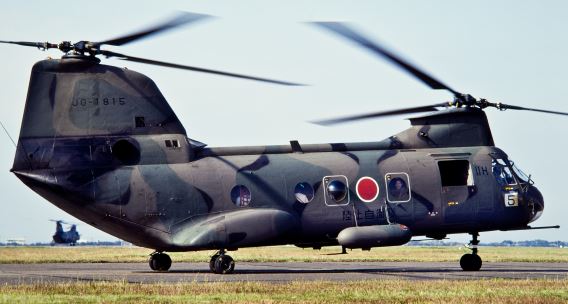 Seen taxying at Kisarazu in October 1986, this 2nd Helicopter Group, 1st Flight KV-107IIA-4
Seen taxying at Kisarazu in October 1986, this 2nd Helicopter Group, 1st Flight KV-107IIA-4
sports the later black, brown and green camouflage. In addition to the removal of the
fuselage identification stripes, the fleet’s hinomaru national markings were moved
from the tail rotor mast to the fuselage in the 1980s. (Photo: Akira Watanabe)
2nd Helicopter Group, 1st Flight/CH-47 era
 (Photo [Takayubaru, April 1995]: Takao Kadokami)
(Photo [Takayubaru, April 1995]: Takao Kadokami)
Initially, aside from the IIH aft of the cockpit, this unit was identified by yellow stripes, one positioned vertically on the nose, and one at an angle on each sponson.
In October 1998, this unit decided to adopt a tail rotor mast marking featuring the long-nosed goblin and famed swordsman Tengu, who is currently also gracing the tails of JASDF 304th Squadron F-15J/DJs. (Tengu statues can be found on Mt. Akagi in Gunma Prefecture.)
Coloured to signify the aircraft’s maintenance crew, a maple leaf was placed behind Tengu’s red and black face, the unit’s radio call-sign AKAGI below. This website page (link) shows the Tengu design’s maple leaf colour variations that were used to distinguish the aircraft’s maintenance teams. From the top down: blue (October 2005); yellow (February 2006); black (October 2006); white (February 2006); two green and purple (all three in October 2006).
Initially, the whole design was on a white background but was toned down, the word AKAGI appearing in white-outlined and then solid black. To ease unit identification, the short yellow stripes were retained on both the nose and, at a rakish angle, on the front of the fuselage-side sponsons.
2nd Helicopter Group, 2nd Flight/KV-107 era
Aside from the IIH Roman numeral/letter combination applied aft of the cockpit windows, the sole identifying marking were two white stripes around the rear fuselage.
For display purposes in 2001, a retired KV-107IIA-4 was painted with the head of a native American/American Indian marking that had been adopted for the unit’s CH-47s in 1993. (See below)
2nd Helicopter Group, 2nd Flight/CH-47 era
 (Photo [Takayubaru, April 1993]: Takao Kadokami)
(Photo [Takayubaru, April 1993]: Takao Kadokami)
 (Photo [Takayubaru, April 1996]: Takao Kadokami)
(Photo [Takayubaru, April 1996]: Takao Kadokami)
Around the autumn of 1993, the marking adopted by this unit comprised the head of a native American/American Indian with a black, white, red and yellow feather headdress in front of crossed arrows above its call-sign Kazusa Flight in white. (Placed on the nose, as seen in the accompanying photos, the warrior faced forward on both sides of the aircraft.)
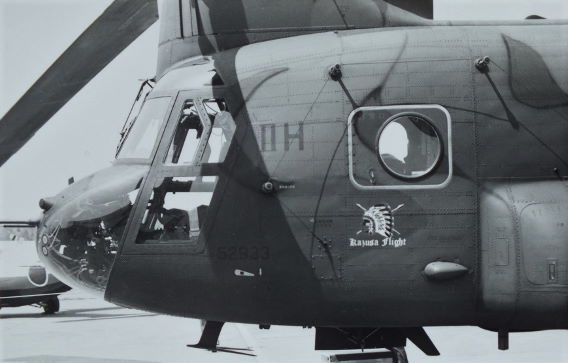 (Photo [Takayubaru, April 1996]: Takao Kadokami)
(Photo [Takayubaru, April 1996]: Takao Kadokami)

(Above and below) Two 1st Helicopter Brigade LR-1s present on a glorious weather day at
Kisarazu in October 1987 show the initial gloss olive drab standard colour scheme (above)
and the new camouflage scheme that had then just been adopted. (Photos: Akira Watanabe)

 Sporting the unit code IHB on its nose, a Raytheon (Beechcraft) LR-2 of the 1st Helicopter
Sporting the unit code IHB on its nose, a Raytheon (Beechcraft) LR-2 of the 1st Helicopter
Brigade HQ Flight taxies in at Kisarazu, circa 2005. Following the formation of a
Liaison & Reconnaissance Flight in March 2006, the resident LR-2s come under
the direct command of the reconstituted 1st Helicopter Brigade but carry
the unit identifier LR, as seen below. (Photo above: JGSDF Kisarazu)
 (Photo taken at Kisarazu September 2017)
(Photo taken at Kisarazu September 2017)
 Tail marking of 1st Helicopter Brigade HQ Control Flight
Tail marking of 1st Helicopter Brigade HQ Control Flight
(Photo taken at Tachikawa, November 2000)
Specially Marked LR-1s (1) / IHB
In 2006, the 1st Helicopter Brigade decided to borrow some Imperial Japanese Army Air Force markings for it LR-1s. In February of that year, 22013 was seen at Kisarazu with a yellow fuselage lightning flash (link), as carried by the Nakajima Ki-43 (Oscar) fighters of the 2nd Company of the 50th Flying Regiment in Burma in 1942.
In October, it was the turn of 22017, which sported the white-edged yellow marking denoting the 3rd Company of the 53rd Flying Regiment (link), which flew Kawasaki Ki-45 (Nick) fighters from Matsudo airfield in Chiba Prefecture in 1944–45. The kaburaya arrow marking of the wartime unit’s Shinten Seikūtai (Heaven-shaking Air Superiority [in other words, ramming attack] Unit) was carried on the wingtip tanks (link); the origins of the markings were provided in an inscription on the rear fuselage.
Specially Marked LR-1s (2) / LR
Seen at Akeno in November 2008, LR-1 22018 had a paper crane-like white bird on its tailfin. These photos show the aircraft from the left (link) in the static park and from the right (link) when taxying.
 The last LR-1 built had a special design added to its tail fin for the 41st Kisarazu airshow in May
The last LR-1 built had a special design added to its tail fin for the 41st Kisarazu airshow in May
2013. Unfortunately, as can be seen better from this angle (link), according to the signwriting
on the aircraft it was the ‘41th’ (sic) event. (Photo via Twitter @gunsou_bouei64)
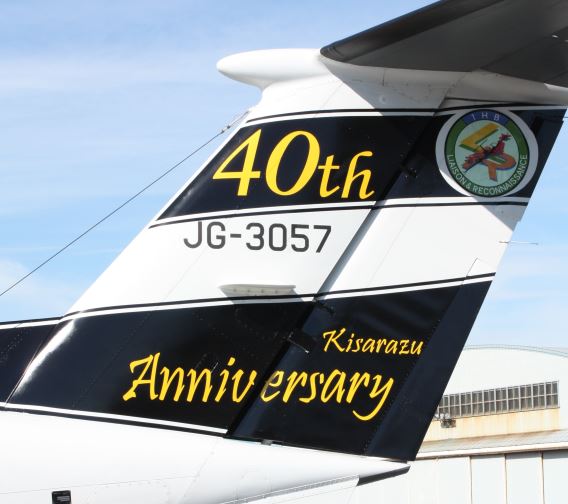 At Kisarazu’s 40th anniversary show in October 2012, the special marking on one of
At Kisarazu’s 40th anniversary show in October 2012, the special marking on one of
the Liaison & Reconnaissance Flight LR-2s incorporates the abbreviation of its
commanding 1st Helicopter Brigade.
|
1st Transport Helicopter Group |
Formed | Mar. 28, 2008 (Kisarazu) |
| Current Base | Kisarazu |
The 1st Transport Helicopter Group was formed from the 1st and 2nd helicopter brigades on March 28, 2008. On that day, the brigade’s two former constituent helicopter units were officially reformed into four (the 103rd to 106th) eight-helicopter squadrons—alongside the newly formed, direct reporting 102nd Squadron’s UH-60JAs—under the overall command of the surviving and reconstituted 1st Helicopter Brigade.
The natural disaster response traditions of its predecessor have continued, most prominently in the aftermath of the Great East Japan Earthquake and tsunami of March 2011. In TV news scenes reminiscent of the Chernobyl nuclear disaster of 1986, CH-47s were shown dropping water onto the stricken reactors at the Fukushima nuclear power station complex.
 From mid-April to late May 2014, 1st Transport Helicopter Group elements flew a number of
From mid-April to late May 2014, 1st Transport Helicopter Group elements flew a number of
firefighting missions over the mountain forests of Gunma and Iwate prefectures. Coordinated
with prefectural-level aviation units, the missions made extensive use of underslung water
buckets, each of which has a capacity of 7,500 litres. (Photo: JGSDF Kisarazu)
Dating back to its predecessor’s era, the 1st Transport Helicopter Group website includes a listing of the major relief operations the unit has conducted in Japan and overseas.
| 1st Helicopter Brigade Chronology of Operations | |
| October 1983 | Volcanic eruption on Miyakejima (part of Tokyo-administered Izu island chain) |
| August 1985 | Japan Airlines disaster, nr. Mt. Osutaka, Gunma Prefecture |
| November 1986 | Volcanic eruption, Mt. Mihara, Izu-Oshima |
| June 1991 | Volcanic eruption, Mt. Unzen/Fugendake, Nagasaki Prefecture |
| July 1993 | Earthquake/tsunami, southwest Hokkaido Prefecture |
| January 1995 | Hanshin-Awaji Earthquake, Kobe, Hyogo Prefecture |
| March 2000 | Volcanic eruption, Mt. Usu, Hokkaido Prefecture |
| Jan. to Mar. 2005 | International earthquake relief operations in Sumatra, Indonesia |
| July 2007 | Chuetsu offshore earthquake, Niigata Prefecture |
| October 2007 | Emergency patient airlift (Kisarazu to Itami, Hyogo Prefecture) |
In the case of the current unit, its website information has been expanded and brought up to date in the following table.
| 1st Transport Helicopter Group Chronology of Operations | |
| Aug. to Nov. 2010 | International earthquake relief operations in Pakistan |
| March to June 2011 | Great East Japan Earthquake |
| March to April 2011 | Nuclear plant disaster, Fukushima Prefecture |
| Nov. 16–25, 2012 | Forest firefighting, Miyakejima, Tokyo |
| Nov. to Dec. 2013 | International typhoon relief efforts in the Philippines |
| Sept. to Oct. 2014 | Volcanic eruption, Mt. Ontake, Nagano Prefecture (Full account under 12th Helicopter Unit in Part 2) |
| September 2015 | Floods in Kanto and Tohoku regions |
| Feb. 15, 2016 | Final flight of last LR-1 |
| Mar. 30 to Apr. 1, 2016 | Forest firefighting, Date, Fukushima Prefecture |
| April to May 2016 | Kumamoto Earthquakes |
| April to May 2017 | Forest firefighting, Fukushima Prefecture |
| May 8–15, 2017 | Forest firefighting, Kamaishi, Iwate Prefecture |
| Jan. 10–11, 2018 | Forest firefighting, Kanra, Gunma Prefecture |
| Apr. 12–14, 2018 | Forest firefighting, Miyako, Iwate Prefecture |
| Sept. to Oct. 2018 | Hokkaido Eastern Iburi Earthquake |
| Apr. 6–7, 2019 | Forest firefighting, Takagimura, Nagano Prefecture |
| Apr. 9–10, 2019 | Forest firefighting, Koriyama, Fukushima Prefecture |
| Sept. to Oct. 2019 | Typhoon No. 15 |
| October 2019 | Typhoon No. 19 |
| Apr. 30 to May 1, 2020 | Forest firefighting, Nanyo, Yamagata Prefecture |
Snapshots of 1st Transport Helicopter Group Operations
 (Photo: JGSDF/1st Helicopter Brigade)
(Photo: JGSDF/1st Helicopter Brigade)
March to June 2011 / Great East Japan Earthquake
 (Photo: JGSDF/1st Helicopter Brigade)
(Photo: JGSDF/1st Helicopter Brigade)
March to April 2011 / Response to Nuclear Plant Disaster, Fukushima Prefecture
 (Photo [March 17, 2011]: JGSDF/1st Helicopter Brigade)
(Photo [March 17, 2011]: JGSDF/1st Helicopter Brigade)
The above photo was taken during the hazardous air operation conducted in a bid to cool the No. 3 reactor of the Fukushima nuclear power station complex. The March 2012 issue of Japan Defense Focus, published by the Ministry of Defense, states that the pair of Chinooks made two runs, during which they dropped around 30 tons of water. Aside from issuing the crews with protective clothing, the safety measures included fitting lead panels to the floors of the helicopters.
JGSDF Chinooks were also fitted with infrared thermal-imaging devices as part of the efforts made to build up a picture of the situation at the stricken plant.
Nov. 16–25, 2012 / Mountain Forest Firefighting, Miyakejima, Tokyo
 November embers (Photo: Japan Ministry of Defense/JGSDF)
November embers (Photo: Japan Ministry of Defense/JGSDF)
It was on the morning of November 16, 2012, that a forest fire broke out on this small island, one of the Izu Island group about 180 km (110 miles) southeast of the capital. As it became obvious that same day that help from outside would be needed, the Tokyo governor lodged a formal request for assistance with the commanding officer of the 1st Division.
The operation was ultimately to involve nearly 200 service personnel and 30 aircraft from the 1st AvSqn and the Eastern Army Aviation Group, the 12th Helicopter Unit as well as the 1st Transport Helicopter Group. It was not until around noon on November 25 that, having received word from the local authorities, the Tokyo governor was in the position to request their withdrawal.
Sept. 27 to Oct. 16, 2014 / Volcanic Eruption, Mt. Ontake, Nagano-Gifu Prefectural Border
 (Photo: JGSDF/1st Helicopter Brigade)
(Photo: JGSDF/1st Helicopter Brigade)
Feb. 15, 2016 / Final Flight of Last LR-1
 The final LR-1 crew runs through the engine startup procedures one last time.
The final LR-1 crew runs through the engine startup procedures one last time.
(Photo: JGSDF Kisarazu)
The 1st Transport Helicopter Group hosted an event to mark the end of an era on February 15, 2016, when the last LR-1 (22019) made its final flight, from Kisarazu.
Mar. 30 to Apr. 1, 2016 / Mountain Forest Firefighting, Date, Fukushima Prefecture
According to a Ministry of Defense press release dated April 1, forest fires near the village of Ryozen had proved too difficult for local response units to bring under control by themselves. The situation prompted the Fukushima Prefecture governor to put in a request for assistance to the 6th Division at Jinmachi, Yamagata Prefecture, at around 15:00 on March 30.
Operations were coordinated by control rooms set up at the Fukushima Prefectural Office and Date City Hall. In addition to ground units, aside from the back-up “heavy guns” from the 1st Transport Helicopter Group the air operation involved the Northeastern Army Helicopter Squadron and the 6th AvSqn. The latter sent an OH-6D on a reconnaissance mission and a pair of UH-1Js to carry out preliminary firefighting that same afternoon, March 30. The results in water-bombing terms amounted to 14 tonnes of water dropped in 20 sorties.
The 6th swung into action again at 05:00 the following morning, launching an OH-6D and a single UH-1J for repeat performances. Around 40 minutes later, a Northeastern Army UH-1J equipped with a camera for transmitting real-time imagery entered the fray on an information gathering mission; another OH-6D was launched for the same reason at around 06:30.
Soon after 07:00, it was time for the first of two 1st Transport Helicopter Group Chinooks to depart Kisarazu; a second followed around 30 minutes later. In between times, single UH-1Js from the Northeastern Army and from the 6th AvSqn carried out morning intelligence gathering and afternoon firefighting work, respectively.
The 6th AvSqn having undertaken a final reconnaissance mission, the JGSDF units were stood down on April 1. The previous day’s Chinook and UH-1J firefighting operations had used a total of 193 tonnes of water on 71 drops.
 (Photo [Kamaishi, Iwate Prefecture, May 2017]: JGSDF/1st Helicopter Brigade)
(Photo [Kamaishi, Iwate Prefecture, May 2017]: JGSDF/1st Helicopter Brigade)
April to May 2016 / Kumamoto Earthquakes
 (Photo: JGSDF/1st Helicopter Brigade)
(Photo: JGSDF/1st Helicopter Brigade)
April to May 2017 / Fighting Forest Fires in Fukushima Prefecture
During this period, 1st Transport Helicopter Group units were also deployed on two occasions to Fukushima Prefecture. Its firefighting efforts were recognized by the presentation of a certificate of appreciation from the prefectural governor in June.
May 8–15, 2017 / Mountain Forest Firefighting, Kamaishi, Iwate Prefecture
 (Photo [Kamaishi, May 2017]: JGSDF/1st Helicopter Brigade)
(Photo [Kamaishi, May 2017]: JGSDF/1st Helicopter Brigade)
The major firefighting incident of recent years came as a result of a fire that broke out in the hills of the Onosaki-Shirahama district above Kamaishi on May 8. Once again, the worsening situation dictated that the prefectural governor make an official request for SDF reinforcements, in this case at lunch time that same day to the regiment garrisoned in the town of Iwate.
Of the total of 44 aircraft that were eventually committed to the fray, local SDF air backup was provided by the 9th AvSqn at Hachinohe and the North and Northeastern Army helicopter squadrons from Okadama and Kasuminome, respectively. On that first day, the 1st Helicopter Brigade deployed eight CH-47J/JAs from its 1st Transport Helicopter Group, supported by five fuel tanker vehicles, and these were assisted by a JASDF aircraft from the Helicopter Airlift Squadron at Misawa.
 Water droplets strike the camera lens in this view from the hatch of a 1st Transport Helicopter
Water droplets strike the camera lens in this view from the hatch of a 1st Transport Helicopter
Group Chinook attending the major fire near Kamaishi in May 2017.
(Photo: JGSDF/1st Helicopter Brigade)
According to a Ministry of Defense press release, the peak of the operation came on the second day, when 16 aircraft shuttled back and forth from the sea and refueling points on no less than 527 sorties, during which they dropped nearly 2,350 tonnes of water.
Over a hard-fought but ultimately successful five-day operation, those 44 aircraft dropped 4,200 tonnes in 1,026 sorties, of which the 1st Transport Helicopter Group accounted for approximately 3,800 tonnes in 759 drops.
 Against a picture-postcard Iwate Prefecture backdrop, this bucolic scene near Kamaishi shows a
Against a picture-postcard Iwate Prefecture backdrop, this bucolic scene near Kamaishi shows a
Chinook from the 1st Transport Helicopter Group’s 103rd Sqn during a break for refueling. The
banner on the tanker indicates that the vehicle is engaged on a disaster relief mission.
(Photo [May 2017]: JGSDF/1st Helicopter Brigade)
Jan. 10–11, 2018 / Mountain Forest Firefighting, Kanra, Gunma Prefecture
 (Photo: JGSDF/1st Helicopter Brigade)
(Photo: JGSDF/1st Helicopter Brigade)
This 28-hour operation involved the operation of 19 helicopters. The 1st Transport Helicopter Group Chinook crews operated in concert with their local counterparts from the 3rd Flight of the 12th Helicopter Sqn at Soumagahara. Support was provided by UH-60Js from the 1st Flight of the 12th Helicopter Sqn at Kita-Utsunomiya and UH-1Js from the Tachikawa, Tokyo-based Eastern Army Helicopter Squadron.
Having broken out near the village of Nanmoku in the Iwado rural district, which is itself in the Kanra district in southwestern Gunma Prefecture, a fire was burning out of control. The Gunma Prefecture governor thus requested assistance from the 12th Brigade at Soumagahara.
On the first day of operations, 130 tons of water were dropped in 26 sorties, on the second 375 tons in 75 sorties, for a total 505 tons in 101 sorties.
 (Photo [Kamaishi, Iwate Prefecture, May 2017]: JGSDF/1st Helicopter Brigade)
(Photo [Kamaishi, Iwate Prefecture, May 2017]: JGSDF/1st Helicopter Brigade)
Apr. 12–14, 2018 / Mountain Forest Firefighting, Miyako, Iwate Prefecture
For this operation, two pairs of 1st Transport Helicopter Group Chinooks departed Kisarazu in the evening of the first day, around three hours after a request for assistance had been made. The target area was near the town of Taro, which forms part of the city of Miyako.
Local ground-based units had been mobilized, and once again geography had dictated that the 9th AvSqn (with an OH-6D) and the Northeastern Army Helicopter Squadron (two UH-1Js) share responsibility for the initial reconnaissance of and aerial assault on the blaze that afternoon.
By 04:30 the following morning, a 9th AvSqn OH-6D and two camera-equipped Northeastern Army Helicopter Squadron UH-1Js had departed from a forward base at the Iwatesan Exercise Area in Takizawa to assess the situation, to be closely followed by two more Northeastern UH-1Js on firebombing missions. Operating from the Northeastern Army Helicopter Squadron’s base, the first pair of 1st Transport Helicopter Group Chinooks lifted off from Kasuminome shortly before 05:00; the other two aircraft deployed singly, departing at 06:25 and 09:00, after further activity by two firefighting UH-1Js and an information-gathering OH-6D from the 9th AvSqn. By the day’s end, 345 tonnes of water had been dropped in the course of 106 sorties.
Despite the launching of four UH-1Js and two Chinooks from Kasuminome, a UH-1J from Hachinohe plus two 9th AvSqn UH-1Js and an OH-6D from Iwatesan, all by shortly after 05:00 on April 14, the units involved were all stood down at 06:40 without having released a single drop of water in anger.
 (Photo [Kamaishi, Iwate Prefecture, May 2017]: JGSDF/1st Helicopter Brigade)
(Photo [Kamaishi, Iwate Prefecture, May 2017]: JGSDF/1st Helicopter Brigade)
Apr. 9–10, 2019 / Mountain Forest Firefighting, Koriyama, Fukushima Prefecture
Following the by now familiar sequence, it was once again the turn of the Fukushima Prefecture governor to request backup in quelling a forest fire, this time in the Tamuramachi area of Koriyama. Received at around 15:00 on April 9 by the 6th Division at Jinmachi, the request set in motion an operation that, fortunately, was only to remain in place until lunchtime the following day.
Following the mobilization of the ground-support units, the 6th AvSqn and Northeastern Army Helicopter Squadron were once again supported by the 1st Transport Helicopter Group. The sequence of events is given in the final version of relevant Ministry of Defense press release, which was issued promptly on April 10:
April 9, 2019 (approx. 7.5 tonnes of water / 15 missions)
15:10 Two video camera-equipped Northeastern Army Helicopter Squadron UH-1Js depart Kasuminome on information-gathering mission
15:43 Three Northeastern UH-1Js depart on firefighting mission
15:52 Two 6th AvSqn UH-1Js depart Jinmachi to act as forward air controllers
16:34 Two 1st Transport Helicopter Group Chinooks depart Kisarazu on aerial firefighting mission
April 10, 2019 (approx. 112.5 tonnes of water / 36 missions)
04:43 Two 1st Transport Helicopter Group Chinooks depart Kisarazu (commence aerial firefighting mission 0547)
04:50 Two 6th AvSqn UH-1Js depart Jinmachi to act as forward air controllers
05:14 Two video camera-equipped Northeastern UH-1Js depart Kasuminome on information-gathering mission
06:58 Three Northeastern UH-1Js depart on firefighting mission
12:45 Following the receipt of a request from the Fukushima Prefecture governor for the SDF assets to withdraw, operations brought to a close
(Total: 120.0 tonnes of water / 51 missions)
Apr. 30 to May 1, 2020 / Mountain Forest Firefighting, Nanyo, Yamagata Prefecture
 A Chinook from the 1st Transport Helicopter Group’s 106th Sqn scoops up another load from
A Chinook from the 1st Transport Helicopter Group’s 106th Sqn scoops up another load from
Lake Birusawa, Yamagata Prefecture, during the May Day operation.
(Photo: JGSDF/1st Helicopter Brigade via Twitter)
In a typical year, spring is a season for fires in Japan. From April 23–29, 10 forest and brush fires broke out in Yamagata Prefecture alone, and a fire warning was in place for a week from April 30.
The first SDF air unit involvement in this incident occurred from around 16:00 on April 29, when firefighting and video imagery transmission duties, to gather information on the spread of the fire, were undertaken by a UH-1J from the 6th AvSqn and the Northeastern Army Helicopter Squadron, respectively. The scene of the fire was only around 40 km from the 6th AvSqn’s base at Jinmachi, and around 100 km from Kasuminome (Sendai). To be in position for the following day’s operations, two 1st Transport Helicopter Group Chinooks departed from Kisarazu and headed to the area at 21:00.
From 04:40 the following day (May 1), two Northeastern UH-1Js relayed real-time images from the scene, including to ground liaison personnel operating from Nanyo City Hall and a local command post at Nanyo Park. With a UH-1J acting as a forward air controller, the two Chinooks commenced aerial firefighting operations from 05:00. Conveniently, Lake Birusawa, which is actually a man-made reservoir, was only four kilometres from the scene of the fire.
At around 09:30, the situation was considered to be within the local authorities’ capabilities, and the request was thus made for the JGSDF units to withdraw.
 Its day’s work done, a Chinook from the 1st Transport Helicopter Group’s 104th Sqn receives the
Its day’s work done, a Chinook from the 1st Transport Helicopter Group’s 104th Sqn receives the
reward of a refreshing shower, and a taste of its own medicine, courtesy the local fire service.
(Photo [Kamaishi, Iwate Prefecture, May 2017]: JGSDF/1st Helicopter Brigade)
Away from the firefighting front lines, The 1st Helicopter Brigade carries the responsibility for the training of heavy-lift helicopter pilots. Thus an event that is a fixture on the Brigade calendar occurs in mid-April, when the graduation ceremonies are held for newly qualified Chinook pilots who have come through the Flight Enlistedman Course (FEC) and Pilot Officer Course (POC). More details on these will be added in due course.
 Two milestones in the V-22 programme that were passed in 2020. The conclusion of training with
Two milestones in the V-22 programme that were passed in 2020. The conclusion of training with
VMMT-204 in the United States in June (above), and the commencement of full-fledged flight
operations outside the confines of Kisarazu, which was marked by a ceremony on November 3.
 (Photos: JGSDF 1st Helicopter Brigade via Twitter @1st_helb)
(Photos: JGSDF 1st Helicopter Brigade via Twitter @1st_helb)
 One of the first pair of JGSDF Boeing V-22B Ospreys delivered to the newly formed Transport
One of the first pair of JGSDF Boeing V-22B Ospreys delivered to the newly formed Transport
Helicopter Group at Kisarazu in July 2020. This photo was taken on November 9, 2020,
the day hovering trials commenced within the base perimeter.
(Photo: 1st Helicopter Brigade, JGSDF via Twitter @1st_helb)
1st Transport Helicopter Group Markings
For details of the constituent unit markings, see the 103rd to 106th squadrons on the JGSDF Squadron Histories Part 2 page.
 A formation of Chinooks airborne from Kisarazu on the first training flight of the New Year.
A formation of Chinooks airborne from Kisarazu on the first training flight of the New Year.
(Photo [Jan. 9, 2020]: JGSDF/1st Helicopter Brigade)
 January 15, 2021. Marking the passing of another year, a formation of 1st Transport Helicopter
January 15, 2021. Marking the passing of another year, a formation of 1st Transport Helicopter
Group Chinooks again takes part in the traditional first training flight. Launched in the time-
honoured fashion following an address by the 1st Helicopter Brigade’s CO, the formation
also involved other Kisarazu-based aircraft and a total of around 70 personnel.
 (Photos: JGSDF/1st Helicopter Brigade via Twitter @1st_helb)
(Photos: JGSDF/1st Helicopter Brigade via Twitter @1st_helb)
 Responsible for the JGSDF officer and sergeant pilot courses, the former including special
Responsible for the JGSDF officer and sergeant pilot courses, the former including special
piloting skills, 1st Transport Helicopter Group Chinooks are used to practise water
landings on Lake Kasumigaura, Ibaraki Prefecture.
(Photo [October 2022]: 1st Helicopter Brigade via X [formerly Twitter] @1st_helb)
 In November 2022, the 1st Helicopter Brigade took part in a remote island disaster exercise
In November 2022, the 1st Helicopter Brigade took part in a remote island disaster exercise
(RIDEX). The setting was that injured persons needed to be airlifted from the heliport on
Kozushima (population 1,800), one of the Izu island chain that lies around 110 miles
(180 km) south of Tokyo and comes under the capital city’s administration.
 (Photos: 1st Helicopter Brigade via X [formerly Twitter] @1st_helb)
(Photos: 1st Helicopter Brigade via X [formerly Twitter] @1st_helb)
 1st Transport Helicopter Group Chinook crews practice deck landings and takeoffs from the
1st Transport Helicopter Group Chinook crews practice deck landings and takeoffs from the
JMSDF tank landing ship Shimokita (LST 4002) off the coast of Kyushu, September 2023.
(Photo: JGSDF Ground Component Command Public Affairs Office via Twitter @jgsdf_gcc_pao)
|
1st AvSqn |
Formed | (NSF) Jan. 10, 1954 (Hamamatsu) (JGSDF) July 1, 1954 |
| Current Base | Tachikawa |
What had started out as the National Safety Force’s 1st Aviation Corps, 1st District, became the JGSDF’s 1st Aviation Corps, 1st District, on July 1, 1954, and moved to Kasumigaura in July 1955. Re-designation as the 1st Aviation Squadron under the command of the Eastern Army Aviation Group followed on January 18, 1962.

1st AvSqn aircraft seen at Tachikawa in May 1980: (Above) An L-19E-1 and a distinctive OH-6D.
(Photos: Akira Watanabe)

Moving from Kasumigaura to Utsunomiya on November 30, 1962, the move to its current base of Tachikawa was made on May 3, 1973. Its time under the command of the Eastern Region Aviation Group came to an end when disbanded and reformed under the 1st Division in March 1994. This photo shows a 1st AvSqn OH-6D overflying Gifu in November 1998 (link).
Due to the operational region of its parent 1st Division incorporating not only Tokyo but also four coastal (Shizuoka, Kanagawa, Chiba and Ibaraki) and two landlocked (Yamanashi and Saitama) prefectures, the 1st AvSqn regularly appears in news media.
Snapshots of 1st AvSqn Operations
Feb. 15–23, 2014 / Response to Heavy Snowfall in Kanto Region
 A 1st AvSqn UH-1J crew on a supply mission to Hayakawa, Yamanashi Prefecture, in mid-February
A 1st AvSqn UH-1J crew on a supply mission to Hayakawa, Yamanashi Prefecture, in mid-February
2014. Home to just 1,050 souls early in 2019, in terms of population Hayakawa currently boasts
the title of Japan’s smallest town. (Photo: Japan Ministry of Defense/JGSDF)
Over a nine-day period following excessive snowfall in the Kanto area, a total of around 5,000 JGSDF personnel, 1,000 vehicles and 130 aircraft were engaged in rescue, supply and snow-clearing operations. During this time, the 1st AvSqn provided airlift support for operations conducted in Yamanashi Prefecture.
 In October 2018, it was the JGSDF’s turn to host the annual SDF troop review at the usual venue,
In October 2018, it was the JGSDF’s turn to host the annual SDF troop review at the usual venue,
the Asaka Training Area in Saitama Prefecture, and Tachikawa contributed a trio of UH-1Js in
vic formation for the flypast. Two of the aircraft are shown en route to the rendezvous point
(above) and the lead aircraft, from the 1st AvSqn, during final flight preparations (below).
 (Photos: JGSDF/1st Division)
(Photos: JGSDF/1st Division)
 A 1st AvSqn UH-1J is made ready for a damage assessment reconnaissance flight after Typhoon
A 1st AvSqn UH-1J is made ready for a damage assessment reconnaissance flight after Typhoon
No. 15 had passed through, mid-September 2019. (Photo: JGSDF/1st Division)
 1st A 1st AvSqn UH-1J during relief operations near the Tokyo town of Okutama in the
1st A 1st AvSqn UH-1J during relief operations near the Tokyo town of Okutama in the
aftermath of Typhoon No. 19 in October 2019. (Photo: JGSDF/1st Division)
 The view from inside the cockpit of a 1st AvSqn UH-1J, likely en route to Okutama,
The view from inside the cockpit of a 1st AvSqn UH-1J, likely en route to Okutama,
during the Typhoon No. 19 operations. (Photo: JGSDF/Eastern Army)
 Having been extensively involved in typhoon relief operations in the two preceding months,
Having been extensively involved in typhoon relief operations in the two preceding months,
it was back to training for 1st AvSqn crews in November 2019. In a simulated scenario,
the unit practiced the coordination of its efforts with those of rescue and medical
organizations in Yamanashi Prefecture. (Photo: JGSDF/1st Division)
1st AvSqn Markings
Seen clearly in the previous photo, the current linked 1 and D marking has been in use since at least 2000. Previously the aircraft carried the Roman numeral I.
 A 1st AvSqn UH-1J and an OH-6D parked at Tachikawa, November 2013.
A 1st AvSqn UH-1J and an OH-6D parked at Tachikawa, November 2013.
|
2nd AvSqn |
Formed | (NSF) Jan. 10, 1954 (Asahikawa) (JGSDF) July 1, 1954 |
| Current Base | Asahikawa |
What had started out on January 10, 1954, as the National Safety Force’s 2nd Aviation Corps, 2nd District, became the JGSDF’s 2nd Aviation Corps, 2nd District, on July 1, 1954.
Possessing no aircraft upon forming, personnel were initially sent to Hamamatsu Aviation School to conduct flight training. Enabling its full functioning as an aviation unit, the long-awaited aircraft had arrived in the form of two L-5s on April 30, 1954. Re-designation as the 2nd Hikōtai (Squadron) followed on September 10 that same year, and the progress made with increasing the numbers of aircraft and personnel extended support and cooperation throughout the district that was its area of responsibility. Its first disaster relief mission occurred on May 7, 1956.
Re-designation as the 2nd Aviation Squadron came when the 2nd District was moved to under the command of the Northern Army Aviation Group on January 8, 1962. Regional aviation group command was supplanted by direct ground divisional command in March 1994.
In keeping with advances in the development of aviation technology and the influence of the Vietnam War, there was a marked shift in JGSDF equipment way from fixed-wing aircraft to helicopters. In the case of the 2nd AvSqn, this culminated in the delivery of its first then HU-1 and OH-6J on March 25, 1976. It was to be exactly 43 years and one day later, March 26, 2019, when the unit retired its last OH-6D, leaving its UH-1Js to soldier on alone for the time being.
Snapshots of 2nd AvSqn Operations
 A 2nd AvSqn UH-1J in action during forest firefighting operations near Omu,
A 2nd AvSqn UH-1J in action during forest firefighting operations near Omu,
Hokkaido Prefecture, in May 2019. (Photo: JGSDF/2nd Division)
Being based in Hokkaido means that the 2nd AvSqn is occasionally called upon to assist in mountain search and rescue (SAR) missions, in both summer and winter, which are normally the preserve of the police and prefectural aviation units. There follow details of some of the episodes formerly described on the unit’s website, which dated back to searches for missing persons in the summer of 2006.
March 13–15, 2007 / Mountain Rescue Mission
 In typical conditions, the survivor of the March 13, 2007, incident is carried from a
In typical conditions, the survivor of the March 13, 2007, incident is carried from a
helicopter to a waiting ambulance. (Photo: JGSDF/2nd Division)
On the afternoon of March 13, 2007, the 2nd Division received an emergency call to search for a missing male in the vicinity of Mt. Shokanbetsu. It was not until 06:20 on March 15, following a successful rescue, that the official stand-down was received.
Basing itself in the town of Mashike, the operation involved a JGSDF ground element of only 12 men in two vehicles. In contrast, the 2nd AvSqn’s contribution amounted to 113 people, nine vehicles and eight helicopters for SAR operations, the airlift of civilian mountain rescue teams and the coordination of communications.
 The helicopter carrying the rescued man comes into land at Rumoi Army Camp.
The helicopter carrying the rescued man comes into land at Rumoi Army Camp.
(Photo: JGSDF/2nd Division)
December 3–4, 2007 / Mountain Rescue Mission
 Mt. Kuro, December 4, 2007. The search and rescue mission that had been initiated the previous
Mt. Kuro, December 4, 2007. The search and rescue mission that had been initiated the previous
day successfully and fortunately comes to an end with the climber being airlifted to
safety by a 2nd AvSqn crew. (Photo: JGSDF/2nd Division)
On the afternoon of December 3, 2007, the 2nd Division received a request from the Hokkaido Prefecture governor to immediately initiate a search for a person reported missing on Mt. Kuro, a 1,984-metre (6,510 ft) peak in the Daisetsu mountain range. Even though that day’s search continued until after sunset, deteriorating weather conditions dictated that a halt be called to operations. Fortunately, after resuming early the following day, a 41-man search party, which included elements from the police, succeeded in locating the missing person, who was airlifted to safety at around 08:30.
On this occasion, a 30-man motorized unit was dispatched to the area from Asahikawa Army Camp along with an OH-6 and a UH-1, supported by a 20-strong support team, from the 2nd AvSqn.
April 21–22, 2008 / Forest Firefighting
 Although not looking too serious from the air, this forest fire needed a large force of 2nd Division
Although not looking too serious from the air, this forest fire needed a large force of 2nd Division
personnel and assets, and two days, to be brought under control. (Photo: JGSDF/2nd Division)
Supporting flight operations conducted by four OH-6s and two UH-1s, a 25-man team from the 2nd AvSqn was sent to quell a forest fire that had broken out in the Rikibiru mountain forest near the small coastal town of Tomomae. Working in concert with a ground element of 153 men and 25 vehicles, the fire was brought under control the following day.
August 24–25, 2010 / Relief Operations Following Landslides
 The extent of the damage caused in just one section by a raging river, and a 2nd AvSqn
The extent of the damage caused in just one section by a raging river, and a 2nd AvSqn
UH-1J picking up evacuees on the road. (Photos: JGSDF/2nd Division)
Following landslides along the sole access road to the Tenninkyo hot springs resort in the Daisetsuzan National Park, the Hokkaido Prefecture governor issued a request for assistance on the afternoon of August 24, 2010.
According to a Kyodo news agency report, heavy overnight rainfall had caused a series of landslides and road collapses, one of which had tragically claimed the life of a man whose car had been swept off a road.
 A UH-1 carrying evacuees departs. (Photo [Aug. 24, 2010]: JGSDF/2nd Division)
A UH-1 carrying evacuees departs. (Photo [Aug. 24, 2010]: JGSDF/2nd Division)
The Tenninkyo resort area lies in the town of Higashikawa, which administratively comes under the city of Asahikawa, where the 2nd AvSqn is based. The relief operation was divided into two airlift missions: of tanks of drinking water to the resort and the evacuation of eight elderly people and pregnant women on the first day; of the other people who had to be evacuated on the second day. During the course of the two-helicopter operation, which could be brought to an end after 24 hours, more than 900 litres or drinking water were flown in and 72 (of the 321 people cut off at the resort) evacuated on 12 flights.
March to May 2011 / Great East Japan Earthquake
 A scene from the first day of the 2nd AvSqn’s participation in the aftermath of the
A scene from the first day of the 2nd AvSqn’s participation in the aftermath of the
Tohoku earthquake and tsunami (Photo [Mar. 19, 2011]: JGSDF/2nd Division)
Although the 2nd Division was mobilized on March 12, 2011, the day after this major disaster struck the Tohoku region of Japan, the first record of 2nd AvSqn involvement is not until a week later, on March 19. On that day, the unit was active on the Omoe peninsula, which is part of the city of Miyako, Iwate Prefecture.
From the following day, March 20, until the unit’s final day of its second period of participation on May 17, the 2nd AvSqn operated from Iwate Army Camp. The division’s ground elements remained until July 10.
From March 20–23, they undertook air support operations across the entire area to which the 2nd Division had been assigned before centering on the Shimokariya district from March 24 to the end of the month.
 A 2nd AvSqn UH-1J crew joins in the search operations along the Iwate Prefecture coast.
A 2nd AvSqn UH-1J crew joins in the search operations along the Iwate Prefecture coast.
(Photo [Apr. 2, 2011]: JGSDF/2nd Division)
After what was presumably a crew rest and aircraft maintenance day, on April 2 the mission switched to three days of air support combined with the unenviable task of assisting in the search for the bodies of tsunami victims along the coastal areas. Air support only was provided on April 5, and reconnaissance missions undertaken on April 6.
 A 2nd AvSqn UH-1J departs Iwate Army Camp to enable its two passengers, the 2nd Division’s
A 2nd AvSqn UH-1J departs Iwate Army Camp to enable its two passengers, the 2nd Division’s
commanding officer and the mayor of Miyako, to assess the situation in the
city from the air. (Photo [Apr. 26, 2011]: JGSDF/2nd Division)
As the emphasis switched to ground searches, recovery in the form of wreckage removal and the provision of support for those affected by the disaster, the 2nd AvSqn seems to have been withdrawn from April 12. The unit was back providing air support in the Shimokariya district and coastal areas from April 23–29, had another break on April 30, and ended its participation with air operation on the Shimokariya peninsula May 1–17.
May 7, 2015 / Forest Firefighting
 (Photo [May 7, 2015]: Ministry of Defense/JGSDF)
(Photo [May 7, 2015]: Ministry of Defense/JGSDF)
The 2nd AvSqn undertook a forest fire containment operation close to home in the Yonehara district of Higashi-Asahikawa. The unit having received the request for assistance at around noon, two UH-1Js were used to gather information and attack the fire, which had been brought sufficiently under control for them to return to base at around 15:00
May 27–30, 2019 / Forest Firefighting
 A liaison team member salutes the crew of a 2nd AvSqn UH-1J upon departure on its next mission
A liaison team member salutes the crew of a 2nd AvSqn UH-1J upon departure on its next mission
during the forest firefighting operations near Omu, Hokkaido Prefecture,
in May 2019. (Photo: JGSDF/2nd Division)
On the afternoon of May 27, 2019, the 2nd Division’s commanding officer received a request from the Hokkaido governor for assistance in combating a forest fire that had broken out near the town of Omu on the prefecture’s north coast. About half an hour later, a 2nd AvSqn UH-1J was dispatched and, during course of four firefighting runs, dropped around two tons of water on the blaze.
The incident was to develop into a major operation. In addition to the Hokkaido prefectural aviation unit, which had been the first to respond and had been forced to call for reinforcements, the operation was eventually to also involve a UH-1J from the JGSDF’s Northern Region Helicopter Squadron at Okadama and CH-47s sent from far-off Kisarazu by the JGSDF’s 1st Helicopter Brigade and from Misawa by the JASDF’s Helicopter Airlift Squadron. Operating in concert with the other units, a 2nd AvSqn crew flew missions over the area on each of the next three days. According to a Ministry of Defense report, a total of 70 tons of water were dropped on 74 missions over the three days on which of water-bombing operations took place.
 Photo [Dec. 2007]: JGSDF/2nd Division)
Photo [Dec. 2007]: JGSDF/2nd Division)
The 2nd AvSqn made headlines on February 7, 2020, when one of its UH-1Js crashed while on a morning training flight. Fortunately, both pilots escaped with minor injuries, the accident having occurred when the aircraft was being held in the hover at a height of only 10 metres within the perimeter of the unit’s Asahikawa base. (The previous JGSDF helicopter incident had been the crash of an AH-64, which tragically had come down on a house in Kanzaki, Saga Prefecture, on February 5, 2018.) News media showed images of the UH-1J keeled over on its side in the snow, and initial reports gave pilot disorientation due to self-induced whiteout conditions as a possible cause.
 Flight and rescue personnel on board a 2nd AvSqn UH-1J undertake their first training
Flight and rescue personnel on board a 2nd AvSqn UH-1J undertake their first training
mission of the new fiscal year in April 2018. (Photo: JGSDF/2nd Division)
 The 2nd AvSqn marked the achievement of 10,000 accident-free flying days on May 31, 2013.
The 2nd AvSqn marked the achievement of 10,000 accident-free flying days on May 31, 2013.
(Photo: JGSDF/2nd AvSqn)
2nd AvSqn Marking
The only unit marking carried by 2nd AvSqn UH-1Js is the Roman numeral II on the side doors.

|
3rd AvSqn |
Formed | (NSF) Jan. 10, 1954 (Hamamatsu) (JGSDF) July 1, 1954 |
| Current Base | Yao |
Having started life as the National Safety Force’s 3rd Aviation Corps, 3rd District, the unit became the JGSDF’s 3rd Aviation Corps, 3rd District, on July 1, 1954, and moved from Hamamatsu to Yao two months later. This photo (link temporarily unavailable) shows a 3rd AvSqn Stinson L-5 parked next to a JASDF F-86D at the unit’s former base of Hamamatsu in March 1958.
As part of a major JGSDF re-organization, the unit was re-designated as the 3rd Aviation Squadron under the Central Army Aviation Group on January 18, 1962.
One of the squadron’s OH-6Ds is seen here at Gifu in November 1999 (link), and YouTube footage exists of the engine start and run-up of another aircraft at Yao (link).
Snapshots of 3rd AvSqn Operations
January 24, 2011 / Mt. Takamikura Forest Fire
 Scenes from the 3rd AvSqn’s involvement during the January 2011 firefighting operation
Scenes from the 3rd AvSqn’s involvement during the January 2011 firefighting operation
(Photos: JGSDF)
Mt. Takamikura straddles the border between the cities of Kakogawa and Takasago in Hyogo Prefecture. The 3rd AvSqn and the Central Army Helicopter Squadron contributed to a combined force of no less than 22 helicopters that was deployed to combat a forest fire that had broken out at around 06:00 that day.
The efforts of prefectural and municipal helicopter operations having failed to stamp out the blaze, reinforcements from the SDF were requested. By the time the operation had been brought to a successful conclusion, the SDF contingent of 168 personnel and 24 vehicles had assisted in the dropping of 454 tonnes of water in 314 sorties.
June 3, 2014 / Forest Firefighting, Aioi, Hyogo Prefecture
 A shot of the June 2014 fire taken from a 3rd AvSqn UH-1J on a reconnaissance mission.
A shot of the June 2014 fire taken from a 3rd AvSqn UH-1J on a reconnaissance mission.
(Photo: JGSDF)
In what was somewhat lower key repeat performance, the 3rd AvSqn and the Central Army Helicopter Squadron operated a total of four helicopters in dealing with a forest fire close to the city of Aioi, Hyogo Prefecture. The mission was accomplished by 17:00 that day.
October 13–14, 2018 / Nankai Rescue 30 Training Exercise
 Wireless communications equipment being unloaded from what is probably a 3rd AvSqn UH-1J during Nankai Rescue 30. (Photo: JGSDF) The same aircraft can be seen in this photo (link), taken the following week during firefighting training at its Yao base.
Wireless communications equipment being unloaded from what is probably a 3rd AvSqn UH-1J during Nankai Rescue 30. (Photo: JGSDF) The same aircraft can be seen in this photo (link), taken the following week during firefighting training at its Yao base.
For many years, experts having been speaking of the potential threat posed by a major offshore earthquake with its epicenter in the Nankai Trough. The objective of this annual exercise is to gauge the effectiveness of plans put in place in anticipation of such an event striking the coastal areas of Wakayama Prefecture.
(Reports on the Nankai Rescue 01 training exercise and the forest firefighting operations in Asago, Hyogo Prefecture, from May 7–11, 2020, can be found in the Snapshots of Central Army Helicopter Squadron Operations section in JGSDF Squadron Histories Part 2.)
 This overhead view of a 3rd AvSqn UH-1J, taken at the port of Amagasaki in Hyogo Prefecture,
This overhead view of a 3rd AvSqn UH-1J, taken at the port of Amagasaki in Hyogo Prefecture,
shows the camouflage on the upper surfaces of the main rotor blades.
(Photo [July 2017]: Hunini via Wikimedia Commons)
3rd AvSqn Marking
Comprising a Roman numeral III flanked by white wings (below), this then newly adopted emblem was seen on a 3rd AvSqn UH-1J at Senzo Army Camp in May 2007.

|
4th AvSqn |
Formed | (NSF) Jan. 10, 1954 (Ozuki) (JGSDF) July 1, 1954 |
| Current Base | Metabaru |
According to the unit’s Japanese-language website (link), having been formed as the NSF’s 4th Aviation Corps, 4th District, on January 10, 1954, the unit was re-designated simply as the 4th Aviation Corps on September 10 of that same year. Other sources imply that the unit retained its name to become the JGSDF’s 4th Aviation Corps, 4th District, when the service was established on July 1, 1954, and state that the 4th District formed the nucleus of the re-designated Western Region Aviation Corps at Ozuki on January 25, 1956.
Responsible for operations in the four prefectures of northern Kyushu (Fukuoka, Saga, Oita and Nagasaki), the unit has been based at Metabaru since relocating there, at that time still as the 4th Aviation Corps, from Ozuki on November 26, 1956.
 A worm’s eye view of Fuji LM-1 21014 parked and tethered in a secluded corner of Oita Airport
A worm’s eye view of Fuji LM-1 21014 parked and tethered in a secluded corner of Oita Airport
in 1957. Although differences of opinion exist, at that time the unit bearing the Roman numeral
IV was still the 4th Aviation Corps, the forerunner of the 4th AvSqn. (Photo: Takao Kadokami)
On January 18, 1962, the unit was re-designated as the 4th Aviation Squadron under the command of the Western Army Aviation Group that formed to replace the Western Region Aviation Corps that same day. The 4th’s long association with the regional command came to end on March 28, 1994, when assigned to a division-level JGSDF ground unit, the 4th Division.
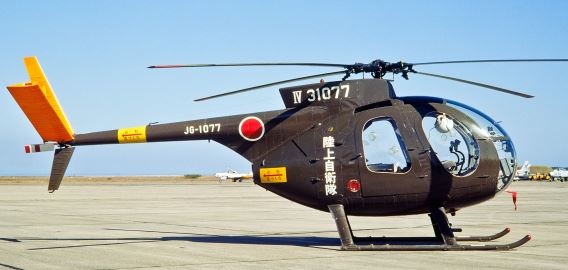 A 4th AvSqn OH-6J sports the typical colour scheme of the day at
A 4th AvSqn OH-6J sports the typical colour scheme of the day at
JASDF Tsuiki in November 1976. (Photo: Akira Watanabe)
 (Photo [JASDF Ashiya, Oct. 1990]: Takao Kadokami)
(Photo [JASDF Ashiya, Oct. 1990]: Takao Kadokami)
The 4th was re-equipped with the UH-1J on March 27, 2003.
 (Above and below) Two scenes from the 4th AvSqn’s involvement in the rescue and disaster
(Above and below) Two scenes from the 4th AvSqn’s involvement in the rescue and disaster
relief operations that followed torrential rainfall in northern Kyushu in July 2017.
 (Photos: Japan Ministry of Defense/JGSDF)
(Photos: Japan Ministry of Defense/JGSDF)
4th AvSqn Marking
 (Photo [JASDF Ashiya, Oct. 1990]: Takao Kadokami)
(Photo [JASDF Ashiya, Oct. 1990]: Takao Kadokami)
The only unit marking usually carried by 4th AvSqn UH-1Js is the Roman numeral IV on the side doors.
|
5th AvSqn |
Formed | September 1954 (Asahikawa) |
| Current Base | Obihiro |
The unit’s Japanese-language website (link) confirms the 5th’s establishment as a JGSDF aviation corps at Asahikawa in September 1954 and that the unit moved to Obihiro that same month. Its Obihiro home base was named Tokachi airfield in 1981.
Re-designated as the 5th Aviation Squadron under the Northern Army Aviation Group on January 18, 1962, the formation of the unit’s “B” Flight was completed in March 1977. Regional aviation group command was supplanted by direct ground (currently brigade-level) command in March 2004.
The unit received its first two examples of the then new OH-6J in March 1972 and its first three UH-1Bs in November 1976; the first UH-1J arrived in September 1995. Taken at Obihiro in March 2004, a photo of a snow-camouflaged 5th AvSqn OH-6D can be found here (link).
A significant milestone was recognized with an award in July 1989, when one of the unit’s helicopters had notched up 3,000 mishap-free flying hours.
Among the more location-specific tasks conducted by the 5th are the supporting of ice floe monitoring operations, which the unit commenced as long ago as February 1957, and surveying the habitat of the local feathered variety of crane in the spring.
Snapshots of 5th AvSqn Operations
February 13–18, 2012 / 5th Brigade Winter Training, Shikaribetsu Exercise Area, Hokkaido Prefecture
 A trio of 5th AvSqn UH-1Js carrying infantrymen are guided into a landing zone within
A trio of 5th AvSqn UH-1Js carrying infantrymen are guided into a landing zone within
the Shikaribetsu Exercise Area, which is located near the town of Shikaoi.
(Photo: JGSDF/Northern Army)
Such exercises are primarily designed to assess whether an infantry regiment is capable of safely completing a given mission task and fully fulfilling its role even under the trying conditions of deep snow and intense cold.
Any participating aviation squadron will also come under intense scrutiny. In this case, the 5th AvSqn was likewise assessed on whether it was able to “complete its mission by making full use of the skills developed and equipment designed for snowy regions” and “enhance its safety management to the level appropriate for extremely testing conditions.”
 An infantryman unhooks a skidoo that a 5th AvSqn UH-1J crew has airlifted to
An infantryman unhooks a skidoo that a 5th AvSqn UH-1J crew has airlifted to
troops during the 2012 winter training exercise. (Photo: JGSDF/Northern Army)
July 17, 2009 / Mt. Tomuraushi SAR Mission
 In weather conditions that belie the strong wind and torrential rain of the night before,
In weather conditions that belie the strong wind and torrential rain of the night before,
a survivor from a trekking party is stretchered to a waiting 5th AvSqn helicopter.
(Photo: JGSDF/Northern Army)
The 5th AvSqn and troops from its parent 5th Brigade took part in rescue efforts as a major tragedy unfolded on Mt. Tomuraushi, a 2,141-metre (7,025ft) peak in Hokkaido’s Daisetsuzan National Park.
Despite their three-day trek having been organized for the height of summer, a tour party of 15 accompanied by four adventure travel company guides had encountered extremely bad weather conditions on the mountain.
Following proper channels, the request from the Hokkaido governor to assist those in distress was received by the 5th Brigade at around 01:00 on July 17 and a 31-man ground element dispatched two hours later. Having joined forces with Hokkaido prefectural police and rescue personnel, a two-team search of the mountain was initiated in conditions that still presented difficulties at 04:30. It was 07:00 when the first survivor was found, by which time two 5th AvSqn helicopters had joined the operation. It was not until 11:20 that the last survivor was located and rescued and 13:00 when the operation was brought to a close.
The following day’s edition of The Japan Times reported that, of those 19 people, who were mostly in their 50s and 60s, eight of the trekkers had succumbed to hypothermia. Five were found conscious and picked up by helicopters, five went back down the mountain by themselves and the other was found safe separately.
 A 5th AvSqn OH-6J crew assists in the search for missing persons along the swollen
A 5th AvSqn OH-6J crew assists in the search for missing persons along the swollen
Pekerebetsu River near the town of Shimizu, Hokkaido Prefecture, in the aftermath
of Typhoon No. 10 in early September 2016. (Photo: JGSDF/5th Brigade)
 Ground personnel prepare a 5th AvSqn UH-1J during a brief forest firefighting
Ground personnel prepare a 5th AvSqn UH-1J during a brief forest firefighting
mission near the town of Shibecha in eastern Hokkaido, May 9–10, 2020.
(Photo: JGSDF Northern Army via Twitter @NorthernArmy_pr)
 The 5th AvSqn was back in firefighting action on May 27, 2020, this time dealing
The 5th AvSqn was back in firefighting action on May 27, 2020, this time dealing
with a blaze in the forests near the town of Omu, Hokkaido Prefecture.
(Photo: JGSDF Northern Army via Twitter @NorthernArmy_pr)
The recipient of letters of appreciation for its accident prevention activities, the 5th was naturally heavily involved in the response to the Great East Japan Earthquake in March 2011.
5th AvSqn Markings
In the early 2000s, 5th AvSqn aircraft were reportedly seen wearing a shield-shaped badge depicting an eagle’s head on which was superimposed 5 Avn above a scroll with the base name OBIHIRO. The only unit marking usually carried by 5th AvSqn UH-1Js today is the Roman numeral V on the side doors.
YouTube Video Featuring 5th AvSqn
Originally shot by the Hokkaido Shimbun, this short YouTube video (link) records the 5th AvSqn’s first training flight of the New Year, of 23 members in five aircraft, on January 9, 2013. (The commentary draws attention to the flatness of a plume of smoke, the result of a weather phenomenon, emanating from the Nippon Beet Sugar Manufacturing plant in Memuro.)
|
6th AvSqn |
Formed | Oct. 15, 1954 (Kasumigaura) |
| Current base | Jinmachi (Yamagata Airport) |
 (Photo:JGSDF/6th Division)
(Photo:JGSDF/6th Division)
Having formed at Kasumigaura, the then 6th Aviation Corps moved to Kasuminome in October 1955 and has been permanently resident at Jinmachi since March 6, 1969. The unit was re-designated as the 6th Aviation Squadron under the Northeastern Army Aviation Group on January 18, 1962.
Following the March 1994 reorganization, the 6th AvSqn parted company from the Northeastern Army Aviation Group to join forces with the 6th Division.
 (Photo: JGSDF/6th Division)
(Photo: JGSDF/6th Division)
Snapshots of 6th AvSqn Operations
April 27, 2014 / Forest Firefighting, Yamagata, Yamagata Prefecture
On the afternoon of the third day of extensive firefighting operations across northern Japan, which involved the 9th AvSqn and 11th AvSqn as well as a JMSDF UH-60J, the 6th AvSqn provided an OH-6D and two UH-1Js to deal with a blaze in the mountains close to the Namegawa hot spring area. In three missions, the unit’s crews dropped a total of around 1.8 tonnes of water.
April 30 to May 10, 2017 / Forest Firefighting, Futaba, Fukushima Prefecture
 A photograph that gives some idea of the potentially hazardous environment in which helicopter
A photograph that gives some idea of the potentially hazardous environment in which helicopter
crews operate when combating forest fires. (Photo: Japan Ministry of Defense via Facebook)
Involving a multi-unit response, this major operation tackled a particularly persistent blaze in the mountainous area called Jumanyama in the town of Namie, which itself lies in the vicinity of the Fukushima Dai-ichi Nuclear Power Plant crippled in the March 2011 tsunami. A call from the Fukushima Prefecture governor to the 6th Division at Jinmachi at noon on April 30 launched what was to be an 11-day operation.
Operated from a sports centre in Namie, a 6th AvSqn UH-1J shared fire-spotting and support duties with a sister aircraft from the Northeastern Army Helicopter Squadron at Kasuminome.
Primarily carried out by Kisarazu-based Chinooks, firefighting operations resulted in 4,570 tonnes of water being dropped from 101 aircraft in the course of 1,170 sorties.
May 14–15, 2019 / Forest Firefighting, Yonezawa, Yamagata Prefecture
 A fine study of a 6th AvSqn UH-1J refilling its fire bucket at a lake during the May 2019
A fine study of a 6th AvSqn UH-1J refilling its fire bucket at a lake during the May 2019
operation in the Oazamisawa District of Yonezawa, Yamagata Prefecture.
(Photo: JGSDF/Northeastern Army via Facebook)
A request for the dispatch of Northeastern Army elements to combat the fire having been received just after noon on May 14, a total of five 6th AvSqn aircraft were launched in support of ground units. In all, 12 tonnes of water were dropped in 24 bombing runs, split exactly over the two days.
6th AvSqn Marking
 A lineup of four 6th AvSqn UH-1Js at Jinmachi. The unit badge on the door can be seen in detail
A lineup of four 6th AvSqn UH-1Js at Jinmachi. The unit badge on the door can be seen in detail
below. No Roman numeral VI is carried at the present time. (Photo: JGSDF/6th Division)
 (From JGSDF/6th Division website)
(From JGSDF/6th Division website)
The same badge formerly carried on the tails of the now withdrawn OH-6Ds can just be made out on this nice photo (link) of a snow-camouflaged example, taken at Yamagata airport in January 2008.
|
7th AvSqn |
Formed | Feb. 28, 1961 (Okadama) |
| Current Base | Okadama |
This unit was first designated as the 7th Aviation Squadron when placed under the command of the Northern Army Aviation Group on August 15, 1962. That chain of command was only broken when supplanted by direct ground divisional command on March 28, 1994.
 (Photo: JGSDF/7th Division)
(Photo: JGSDF/7th Division)
Joined by its sister unit (now the 11th AvSqn) in January 1962, the 7th AvSqn has been stationed at Okadama for 55 years.
 A unit photo taken to mark the 7th AvSqn’s 50th anniversary in 2012, which coincided with the
A unit photo taken to mark the 7th AvSqn’s 50th anniversary in 2012, which coincided with the
completion of a new hangar at JGSDF Okadama Base Camp. (Photo: JGSDF/7th Division)

(Above and below) Two specially adorned 7th AvSqn helicopters were present at
the 50th anniversary ceremony. (Photos: JGSDF/7th Division)

7th AvSqn Markings

The unit marking of the 7th AvSqn comprises a stylized red Roman numeral seven (VII), denoting its commanding 7th Division, and a white feather. Superimposed in yellow is 七飛 (seven, fly), an abbreviation of the unit designation 第七飛行隊 to denote allegiance to that command division. The unit’s long association with the city of Sapporo is also recognized. At least one variation of this design has appeared on the nose of a UH-1H (date unknown, [link]). In 2005, a red version was seen carried on the rotor mast of an OH-6D at Okadama.
More usually, the only unit marking carried by 7th AvSqn UH-1Js is the Roman numeral VII on the side doors.
 (Above and below) At an Okadama base event in July 2022, a UH-1J had been partly
(Above and below) At an Okadama base event in July 2022, a UH-1J had been partly
given the retro, high-viz appearance of a UH-1B from the late 1970s.
 (Photos, via X [formerly Twitter]: [Top] スイトウさん @suitou_sa;
(Photos, via X [formerly Twitter]: [Top] スイトウさん @suitou_sa;
[above] JGSDF/7th Division @7th_division_pr)
See the July 2023 Bulletin Board story for a photo of the special digital scheme, again applied to the same UH-1J as above, for Camp Okadama’s 70th anniversary.
|
8th AvSqn |
Formed | Jan. 18, 1962 (Takumabaru) |
| Current Base | Takayubaru |
Formed on the day a major JGSDF reorganization came into effect, the 8th Aviation Squadron immediately came under the control of the Western Army Aviation Group. Its initial equipment was the L-19 Bird Dog, flown from Takumabaru Army Camp in the city of Kumamoto.
 8th AvSqn L-19A at JASDF Tsuiki AB in November 1978 (Photo: Takao Kadokami)
8th AvSqn L-19A at JASDF Tsuiki AB in November 1978 (Photo: Takao Kadokami)
 The 8th AvSqn sent another Bird Dog, this time an L-19E-1, to the Tsuiki air show in
The 8th AvSqn sent another Bird Dog, this time an L-19E-1, to the Tsuiki air show in
January 1980. (Photo: Takao Kadokami)

8th AvSqn aircraft at Takayubaru: (above) an L-19A in March 1976 and an OH-6D in April 1981
(Photos: Takao Kadokami)

Responsible for operations in southern Kyushu, the unit relocated the short distance to Takayubaru Army Camp, at Kumamoto airport, in 1971 and was eventually placed under divisional command in 1996. One of the squadron’s OH-6Ds is seen here at Gifu in September 1999 (link).
 OH-6J / (Photo [Takayubaru, April 1989]: Takao Kadokami)
OH-6J / (Photo [Takayubaru, April 1989]: Takao Kadokami)
 OH-6D / (Photo [JASDF Nyutabaru, November 1997]: Takao Kadokami)
OH-6D / (Photo [JASDF Nyutabaru, November 1997]: Takao Kadokami)
The 8th Division’s aviation unit for some time operated the UH-1J/OH-6D combination but has recently re-equipped to be solely a UH-60JA unit.
 A trio of 8th AvSqn UH-60JAs over the Kumamoto countryside. (Photo: JGSDF/8th Division)
A trio of 8th AvSqn UH-60JAs over the Kumamoto countryside. (Photo: JGSDF/8th Division)
Snapshots of 8th AvSqn Operations
May 29 to June 1, 2015 / Volcanic Eruption on Kuchinoerabujima
The 8th AvSqn formed a small but essential cog in an extensive tri-service SDF wheel for an operation triggered by the eruption of Mt. Shindake on Kuchinoerabujima. The island forms one of the Osumi group, located around 130 km (70 nm) south of the city of Kagoshima, which fall under the local jurisdiction of nearby Yakushima and at the prefectural level under Kagoshima. The situation ultimately warranted the evacuation of the island’s 140 inhabitants by the Japan Coast Guard.
The 8th AvSqn shared airlift duties with the Western Region Air Squadron as elements of the 8th Division were mobilized as part of the initial response. By the time the JGSDF units were given the order to stand down, late in the afternoon on June 1, their contribution had involved around 430 personnel, 20 vehicles and 40 aircraft.
March 24, 2020 / Forest Firefighting, Ebino, Miyazaki Prefecture
 (Photo: JGSDF/8th Division)
(Photo: JGSDF/8th Division)
Two 8th AvSqn UH-60Js were called in to conduct evening firefighting operations after two Western Army Helicopter Squadron UH-1Js had been sent to gather information and relay images from the scene.
July 2020 / Kyushu Floods (Kuma, Kumamoto Prefecture)
 (Photo: JGSDF Western Army via Twitter @JGSDF_WA_pr)
(Photo: JGSDF Western Army via Twitter @JGSDF_WA_pr)
In the above photo, a wheelchair-bound survivor of the flooding in Kumamoto Prefecture is moved under arduous conditions toward a waiting 8th AvSqn UH-60JA. In July 2020, the unit was heavily involved in rescue and relief operations along the Kuma River, which had burst its banks as a result of record-breaking rainfall. Aside from the cost in human terms—77 people lost their lives—large areas were devastated by the unprecedented disaster.
Pilot Profile
An 8th AvSqn pilot was interviewed as one of a series of SDF profiles that appeared on The Sankei News website in October 2019. On March 20 that year, Lt. Col. Junji Katsumoto had once again brought in a UH-60J into land at Takayubaru, adjacent to Kumamoto airport. It was only after applying the rotor brake that he burst into floods of tears—at the age of 55, he had just completed his last flight.
As a boy, it had been his ambition to fly crop-spraying helicopters, but he had joined the JGSDF after graduating high school in 1983. Ground based, his first posting had been to Okinawa, where he was responsible for liaison between the 1st Composite Brigade (now the 15th Brigade) and U.S. forces. After seven years he seized his last chance to apply to take the helicopter pilot exam, which is limited to those up to 25 years old, his then age.
Having successfully changed course, his first posting was to the Northern Army Helicopter Squadron, where he gained experience in transporting the victims of natural disasters, including the Hokkaido Earthquake of July 1993. Himself an instructor at Akeno Aviation School in February 2004, he still feels sadness at the loss of two colleagues killed along with a trainee when two AH-1S helicopters collided in midair.
Katsumoto went on to clock up 6,500 accident-free flying hours in a career that spanned 30 years. The sage safety advice of his instructor during his helicopter qualifying days—“Always be watchful, attentive and careful”—had stayed with him throughout his career.
 (Photo: JGSDF/8th Division)
(Photo: JGSDF/8th Division)
8th AvSqn Markings
 OH-6Ds / (Photo [Takayubaru, April 2003]: Takao Kadokami)
OH-6Ds / (Photo [Takayubaru, April 2003]: Takao Kadokami)
From its earliest days, the unit had followed suit by using the Roman numeral VIII. By late 1997, 8th AvSqn aircraft were sporting the ‘8th Cavalry’ badge seen in the photographs included here. However, its current UH-60JAs are currently devoid of any unit identification.
 (Photo [OH-6D, Takayubaru, April 2003]: Takao Kadokami)
(Photo [OH-6D, Takayubaru, April 2003]: Takao Kadokami)
|
9th AvSqn |
Formed | Feb. 20, 1957 (Kasuminome) |
| Current Base | Aomori |
Sources differ as to when the former 9th Aviation Corps officially came into being: another states September 27, 1956. Whenever that may have been, there is no doubt that re-designation as the 9th Aviation Squadron took effect on January 18, 1962. The 9th moved to Hachinohe in March 1957 and has remained there ever since.
Taken early in 1974, a great air-to-air photo of a 9th AvSqn L-19A over a snow landscape can be found here (link).
 9th AvSqn L-19A at Misawa in September 1977 (Photo: Akira Watanabe)
9th AvSqn L-19A at Misawa in September 1977 (Photo: Akira Watanabe)
This same aircraft had been photographed in flight from another aircraft three years earlier (link).
Following the March 1994 reorganization, the 9th AvSqn had parted company from the Northeastern Army Aviation Group to join forces with the 9th Division. An OH-6D from this low-profile unit was present at JASDF Misawa in September 2005 (link).
Snapshots of 9th AvSqn Operations
 A 9th AvSqn UH-1J overflies Iwate Town Hall the day after Exercise Michinoku Alert in
A 9th AvSqn UH-1J overflies Iwate Town Hall the day after Exercise Michinoku Alert in
November 2018. (Photo: きは (kiha) via Twitter @kiha52_149)
March 2011 / Great East Japan Earthquake
In the aftermath of the Great East Japan Earthquake, the 9th AvSqn was charged with the airlift of personnel and materiel between its home base at Hachinohe and Iwate-Hanamaki Airport.
April 27, 2014 / Forest Firefighting, Morioka, Iwate Prefecture
On the afternoon of the third day of extensive firefighting operations across northern Japan, which involved the 6th AvSqn and 11th AvSqn as well as a JMSDF UH-60J, the 9th AvSqn provided a UH-1J to focus on a blaze close to the Tamayama district of Morioka.
May 31, 2014 / Forest Firefighting, Kamaishi, Aomori Prefecture
 The 9th AvSqn UH-1J called in for firefighting duties in Kamaishi makes use of open ground
The 9th AvSqn UH-1J called in for firefighting duties in Kamaishi makes use of open ground
within sight of the Daikannon Statue, a prominent landmark in the city.
(Photos [May 31, 2014]: JGSDF)
Having provided just one of several helicopters for the previous month’s major operation, a solo 9th AvSqn UH-1J was brought in to help ground units tackle a blaze in a forest located in the Ryoishicho district of Kamaishi. After gathering information at the scene, the crew proceeded to carry out firefighting operations. The request for assistance having been received by the JGSDF unit at Iwate Army Camp at 13:20, the request for all units to withdraw, which also has to be received from the prefectural governor, came at 18:10.
 (Photo [2014]: Ministry of Defense via Wikimedia Commons)
(Photo [2014]: Ministry of Defense via Wikimedia Commons)
April 28–29, 2015 / Forest Firefighting, Daisen, Akita Prefecture
Local firefighting units having failed to bring a blaze in the Kyowainazawa district of Daisen under control, SDF units were mobilized on the afternoon of April 28, 2015.
The 9th AvSqn UH-1J that departed on an information-gathering mission just before 16:00 was followed by another that carried out firefighting operations in concert with a Misawa-based JASDF CH-47J. The day’s tally was 28.5 tonnes of water dropped in the course of 10 sorties.
The 9th recommenced firefighting operations on its own before 06:00 the following day, the two helicopters completing the task sufficiently for them to be withdrawn at 11:15. The total amount of water dropped over the two days came to 45.3 tonnes in 34 sorties.
May 8-15, 2017 / Mountain Forest Firefighting, Shirahama District, Kamaishi, Iwate Prefecture
 A 9th AvSqn UH-1J in action during the major May 2017 operation in Kamaishi.
A 9th AvSqn UH-1J in action during the major May 2017 operation in Kamaishi.
(Photo: Japan Ministry of Defense)
A request for assistance received from the Iwate Prefecture governor at lunch-time on May 8 triggered what was to become a major eight-day operation that involved 44 aircraft flying a total of 1,026 sorties.
A Ministry of Defense press release records that the 9th AvSqn was operated alongside the helicopter squadrons from the north and northeastern armies, and that JGSDF Chinook helicopters from Kisarazu were teamed up with their JASDF counterparts drafted in from Kisarazu. The height of the operation came on May 9, when 16 aircraft dropped 2,347 tonnes of water on 527 sorties.
Compared with the average scale of such operations over the previous 10 years, the number of days was 3.3 times longer, the number of aircraft was 3.4 times greater, and the roughly 4,200 tonnes of water dropped 15 times the average amount.
 A 9th AvSqn UH-1J comes into land at Hirosaki University Hospital in Aomori Prefecture
A 9th AvSqn UH-1J comes into land at Hirosaki University Hospital in Aomori Prefecture
during a training exercise held in June 2018. (Photo: JGSDF Northeastern Army via Facebook)
November 9-10, 2018 / Exercise Michinoku Alert 2018
 The 9thAv Sqn UH-1J exhibited at Iwate Town Hall as an add-on event the day after Exercise
The 9thAv Sqn UH-1J exhibited at Iwate Town Hall as an add-on event the day after Exercise
Michinoku Alert had ended. (Photo: きは (kiha) via Twitter @kiha52_149)
The historical name for what is today’s Tohoku region was chosen for this regular integrated training exercise, which is designed to practice the disaster relief strategies derived from the lessons learned from before and after the Great East Japan Earthquake of March 2011.
Large stretches of its coastline having fallen victim to the tsunami triggered by that earthquake, Iwate had been struck by the Iwate-Miyagi Nairiku Earthquake in June 2008 and was to be scene of more devastation when Typhoon No. 10 tracked through in September 2016. Thus not only SDF units but also local authorities have to maintain a high level of preparedness.
Involving 10,000 SDF personnel, the first Michinoku Alert tsunami drill had taken place in the autumn of 2008, not long after the 2008 disaster. Fortunately, a manual based on the findings and recommendations from the 2008 earthquake and that first exercise was in place before the March 2011. The 2014 version exercise had taken place over four days and featured U.S. and Australian military units in a scenario based on the assumption that an earthquake had struck off the coast of Miyagi Prefecture.
This latest exercise involved training at four venues, the main one being located in the coastal city of Miyako, simulating the aftermath of a tsunami along the region’s Sanriku coastline, which extends from southern Aomori Prefecture to northern Miyagi Prefecture. In addition to the SDF and the disaster relief organizations of the six Tohoku region prefectures a total of 11 cities, seven towns and one village took part.
The first day was devoted to coordinating the initial response operations, the second to the airlift and transport of relief supplies, with the 9th AvSqn reprising the role it had fulfilled for real in March 2011.
9th AvSqn Marking
The only unit marking usually carried by 9th AvSqn UH-1Js is the Roman numeral IX on the side doors.
|
10th AvSqn |
Formed | 1961 (Akeno) |
| Current Base | Akeno |
Yet again, sources differ on the formation date of what was originally the JGSDF’s 10th Aviation Corps. Although some state June or July 1958, the unit website’s sketchy Japanese-language chronology (link) puts the ubugoe (newborn baby’s first cry) at Akeno as late as at some stage in 1961.
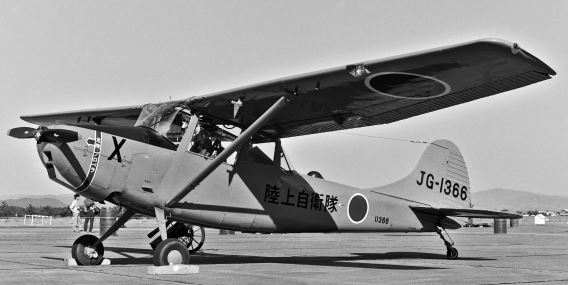 An overall orange 10th AvSqn L-19E-2 at Hamamatsu in August 1972 (Photo: Akira Watanabe)
An overall orange 10th AvSqn L-19E-2 at Hamamatsu in August 1972 (Photo: Akira Watanabe)
Re-designation as the 10th Aviation Squadron came on January 18, 1962, as did a move from Hachinohe to Akeno. According to the unit’s website, found via that of its commanding 10th Division (link), it was here that the 50th anniversary was marked on January 18, 2012.
A fine study shows an OH-6D from the unit coming in for a landing at Akeno in October 1997 (link).
Following the March 1994 reorganization, the 10th AvSqn parted company from the Central Army Aviation Group to join forces with the 10th Division. The unit’s area of responsibility thus matches that of the division and covers the six prefectures that form the Tokai and Hokuriku regions.
 10th AvSqn OH-6D 31306 parked at JASDF Komaki AB in February 2014.
10th AvSqn OH-6D 31306 parked at JASDF Komaki AB in February 2014.
(Photo: Hunini via Wikimedia Commons)
Snapshots of 10th AvSqn Operations
May 29–30, 2013 / SAR Mission, Mt. Shakagatake, Mie Prefecture
 (Photo: JGSDF/10th Division)
(Photo: JGSDF/10th Division)
In addition to 15 vehicles and 60 personnel on the ground, a single OH-6D was flown in the information gathering role in support of efforts to find a climber reported missing on this 1,800-metre (5,800ft) peak.
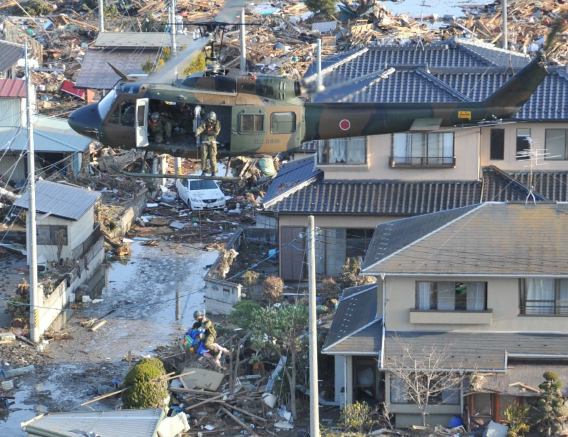 The 10th AvSqn was heavily involved in rescue operations in the aftermath of the
The 10th AvSqn was heavily involved in rescue operations in the aftermath of the
tsunami triggered by the Great East Japan Earthquake of March 2011.
(Photo: JGSDF/10th Division)
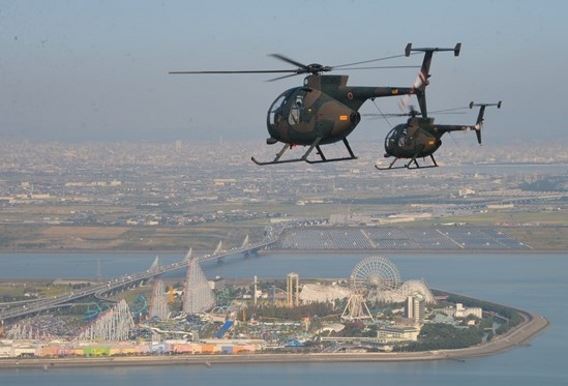 A pair of 10th AvSqn OH-6Ds approach Nagashima Spa Land, an amusement park located
A pair of 10th AvSqn OH-6Ds approach Nagashima Spa Land, an amusement park located
in Kuwana, Mie Prefecture, close to Nagoya. (Photo: JGSDF/10th Division)
 A 10th AvSqn OH-6D wows the crowd while fulfilling publicity/recruitment duties at the JGSDF
A 10th AvSqn OH-6D wows the crowd while fulfilling publicity/recruitment duties at the JGSDF
garrison at Sabae, Fukui Prefecture, in September 2015.
(Photo: i北陸 [i-Hokuriku] / Hokuriku region official event and tourist destination blog [link])
 A ceremony held in front of the hangar to congratulate the two 10th AvSqn pilots who made their debuts
A ceremony held in front of the hangar to congratulate the two 10th AvSqn pilots who made their debuts
as aircraft commanders on two-hour training flights held on consecutive days in April 2017. Having
had water thrown over them, ostensibly to wash away the nervous sweat, the newly promoted pilots
can be identified by their wet and thus darker uniforms. (Photo: JGSDF/10th Division)
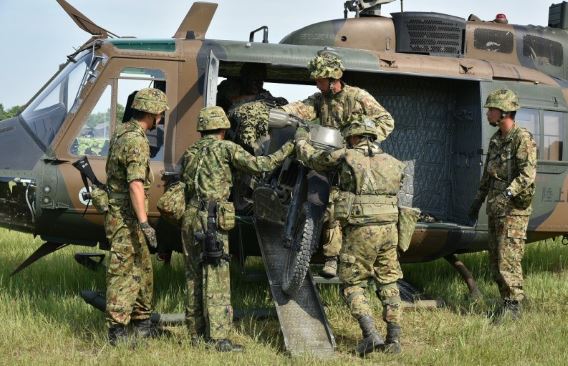 A motorbike is unloaded from a 10th AvSqn UH-1J during an away from base deployment training
A motorbike is unloaded from a 10th AvSqn UH-1J during an away from base deployment training
exercise conducted by the 10th Division in July 2017. (Photo: JGSDF/10th Division)
 A 10th AvSqn OH-6D gains speed after takeoff having waved the JGSDF flag at the
A 10th AvSqn OH-6D gains speed after takeoff having waved the JGSDF flag at the
JASDF Komaki airshow in March 2018. (Photo: Hunini via Wikimedia Commons)
January 6, 2020 / First Formation Training Flight of New Year

A study in concentration, the commanding officer of the 10th AvSqn, Lt. Col. Kenji Niioka (above), carefully colours in the eyes of a daruma talisman. While conducting this annual ritual, which will be repeated at other SDF bases, tradition dictates that he make a wish. The now “all-seeing” daruma is believed to have the power to safeguard the lives of all squadron personnel during and long after the first formation training flight, which is undertaken after the CO has given his New Year address and the taking of a statutory squadron group photo (below). (Photo: JGSDF/10th AvSqn)
 (Photo: JGSDF/10th AvSqn)
(Photo: JGSDF/10th AvSqn)
 (Photo: JGSDF/10th AvSqn)
(Photo: JGSDF/10th AvSqn)
 (Photo [Nov. 3, 2019]: JGSDF/10th AvSqn)
(Photo [Nov. 3, 2019]: JGSDF/10th AvSqn)
 One of the major recent events in the annals of 10th AvSqn history was the retirement of the
One of the major recent events in the annals of 10th AvSqn history was the retirement of the
OH-6D on March 17, 2020. (Photo: JGSDF/10th AvSqn)
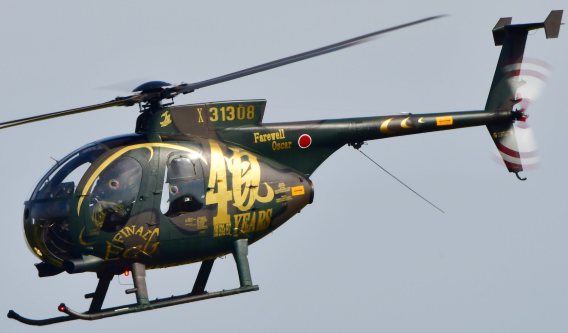 At the Akeno airshow held in early November 2019, the 10th AvSqn painted its two remaining OH-6Ds in
At the Akeno airshow held in early November 2019, the 10th AvSqn painted its two remaining OH-6Ds in
special markings for their final appearance at the event. Both aircraft carried a large ‘40’
incorporating the kanji 完 (kan), meaning completion, in gold on the left and black on the
right of their fuselages. The gold design on one aircraft also included ‘193 EGGs Flt’,
‘egg’ being the OH-6Ds nickname, beneath the ‘40’ and a shachihoko (see
10th AvSqn Markings below) on the rotor mast. Both aircraft bore the
words COMPLETE MISSION GOOD DAY!! on their undersides.
(Photos: ぷに一 [@NikonskyF16])

 (Photo: ぷに一 [@NikonskyF16])
(Photo: ぷに一 [@NikonskyF16])
 Akeno Army Camp, March 17, 2020. 10th AvSqn personnel look on as one of the unit’s last two
Akeno Army Camp, March 17, 2020. 10th AvSqn personnel look on as one of the unit’s last two
OH-6Ds, which had both previously been specially painted, departs for the last time.
(Photo: JGSDF/10th AvSqn)
 (Image: JGSDF / !0th AvSqn)
(Image: JGSDF / !0th AvSqn)
As included on the unit’s website, the 10th AvSqn badge (above) features the Roman numeral X flanked by a pair of shachihoko against a map of the six prefectures that are the 10th Division’s area of responsibility. Up to now, aircraft have tended to carry a disc-shaped version of the 10th Division badge, as shown below.
10th AvSqn Markings
The 10th AvSqn’s aircraft have been known to carry the 10th Division’s badge, as was seen on the door of a UH-1J that visited Hisai Army Camp, Mie Prefecture, in April 2013. In August 2016, the 10th AvSqn sent a badge-carrying OH-6D north to the Crossland Oyabe (link) Helicopter and Fire/Crime Prevention Festival. The badge design features the mythical half fish, half tiger creature known as a shachihoko, which adorns the corners of the roof of Nagoya Castle (and, again in badge form, the tail fins of JASDF C-130Hs flown by the Komaki-based 401st Airlift Sqn).
More recently, one of the unit’s UH-1Js was photographed (link) at Fukui airport in November 2019 with a shachihoko marking forward of the door serial number. The aircraft was filmed at the same location that very day (see below).
 The OH-6D that the 10th AvSqn sent to the Crossland Oyabe Helicopter and Fire/Crime Prevention
The OH-6D that the 10th AvSqn sent to the Crossland Oyabe Helicopter and Fire/Crime Prevention
Festival, Toyama Prefecture, in August 2016. The aircraft carried a disc version of the
10th Division emblem (below), sometimes seen forward of the door serial numbers of
UH-1Js ([link] from Nov. 2011), in front of the serial number on the rotor mast.
(Photo: i北陸 [i-Hokuriku] / Hokuriku region official event and tourist destination blog [link])
 (Image via Wikimedia Commons)
(Image via Wikimedia Commons)
 The ‘mission complete’ placard announcing the end of the unit’s OH-6D operations was
The ‘mission complete’ placard announcing the end of the unit’s OH-6D operations was
also decorated with a pair of shachihoko. (Photo [Mar. 17, 2020]: JGSDF/10th AvSqn)
 JGSDF Akeno Army Camp, March 17, 2020. 10th AvSqn personnel look on as the unit’s last two
JGSDF Akeno Army Camp, March 17, 2020. 10th AvSqn personnel look on as the unit’s last two
OH-6Ds recede into the distance. (Photo: JGSDF/10th AvSq)
YouTube Videos Featuring 10th AvSqn
Filmed in June 2015, this video (link) shows a pair of UH-1Js coming into land; another (link) recorded flight training at Akeno airfield in August 2017.
As mentioned above, a more recent video (link) shows a 10th AvSqn UH-1J starting up at and departing from Fukui airport in November 2019.
 (Photo: JGSDF/10th Division)
(Photo: JGSDF/10th Division)
|
11th AvSqn |
Formed | January 1962 (Okadama) |
| Current Base | Okadama |
What is today the 11th AvSqn has its origins in the Artillery Brigade Aviation Corps that was formed at Kita-Chitose Army Camp* outside Sapporo in January 1954 and renamed the 1st Artillery Brigade Aviation Corps upon the founding of the JGSDF that July.
 Undated photos from the unit’s now superseded website, accessed in mid-October 2017, show (left)
Undated photos from the unit’s now superseded website, accessed in mid-October 2017, show (left)
an L-19 undergoing maintenance and an H-13, the 11th’s equipment during its formative years.
(Photos: JGSDF/11th Brigade)
Coinciding with the formation of the 11th Division, the 11th AvSqn was newly established in January 1962 alongside the 7th AvSqn (until that month the former 7th Aviation Corps) at Okadama.
 The scene at Okadama after the arrival of the 11th AvSqn’s first OH-6J in 1972.
The scene at Okadama after the arrival of the 11th AvSqn’s first OH-6J in 1972.
(Photo: JGSDF Camp Okadama via Twitter @camp_okadama)
The formation of a “B” Flight brigade squadron was completed in March 1978. Regional aviation group command was completely supplanted by direct ground (currently brigade-level) command in March 1994. A crew member looks down from one of the squadron’s OH-6Ds upon departure from Gifu following maintenance in November 1999 (link).
 On March 27, 2017, a photo was taken to commemorate the 11th AvSqn having completed the
On March 27, 2017, a photo was taken to commemorate the 11th AvSqn having completed the
process of becoming solely a UH-1J unit. (Photo: JGSDF/11th Brigade)
 An Okadama-based 11th AvSqn flight crew keep their UH-1J steady as a likewise ski-equipped
An Okadama-based 11th AvSqn flight crew keep their UH-1J steady as a likewise ski-equipped
soldier abseils to the ground. Note the crudely secured cladding to protect the undersides
from snow. (Photo: JGSDF Takikawa Canp via Twitter @TakikawaCamp)
 In August 2020, an 11th AvSqn pilot receives essential guidance during practice landings in and
In August 2020, an 11th AvSqn pilot receives essential guidance during practice landings in and
takeoffs from a purpose-built emplacement at the Hokudaien Training Area, Hokkaido Prefecture.
(Photo: JGSDF 11th Brigade via Twitter @11b_na_jgsdf)
11th AvSqn Markings

The samurai helmet with pilot’s visor badge (above) used to appear of the tails of now retired OH-6Ds (link) and can still be found on the noses of the unit’s UH-1Js (link). The latter will also carry the Roman numeral XI on their side doors.
As pictured in the September 2003 issue of the now defunct Air World, an 11th AvSqn UH-1J appeared at the Sky High 2003 event at Okadama, which marked the base’s 50th anniversary, with a hardly festive but unusual low-visibility black and grey sharkmouth design.
 Former commanding officer Lt. Col. Kuniyuki Tsuchiko stands front and centre of another
Former commanding officer Lt. Col. Kuniyuki Tsuchiko stands front and centre of another
11th AvSqn unit photo, probably taken at the time of Tsuchiko’s departure to command the
Northern Army Helicopter Sqn in August 2018. (Photo: JGSDF/11th Brigade)
(*) The former 11th Aviation Squadron page on the 11th Brigade website mentioned Kita-Chitose in the text and Higashi-Chitose in a chronology; the unit’s current webpage (link) states Kita-Chitose.


